All products
-
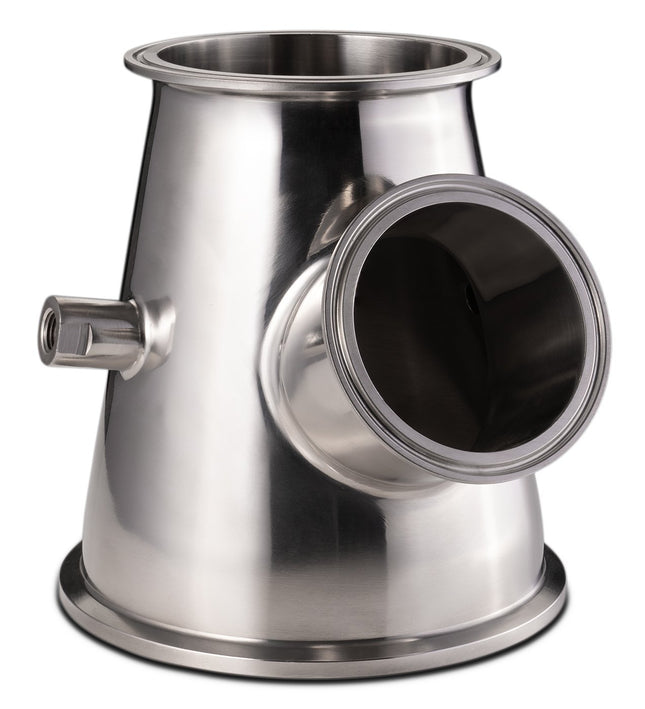
6" x 4" x 3" x (2) 1/4" FNPT Tri-Clamp Skylight
Specifications: 304 Grade Stainless Steel Reducer 'Skylight' w/ High Polish interior 6" Triclamp x 4" Triclamp x 3" Triclamp (Can be used as viewport to see inside) x (2)1/4" FNPT 7" Tall
$196.06
-
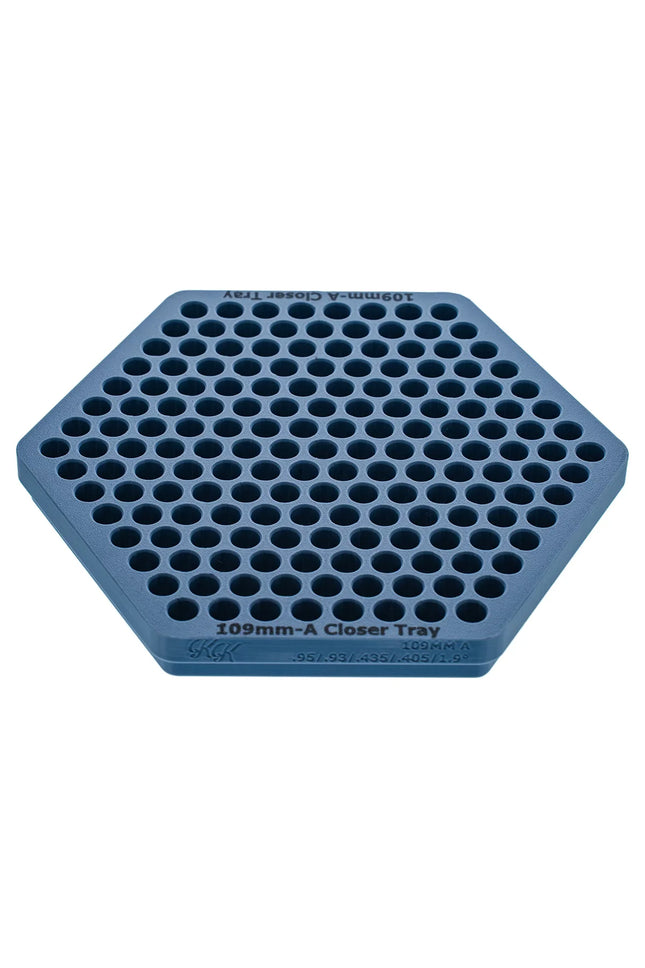

King Kone Receiving Tray - 70mm, 84mm, 98mm, 109mm
Receiving Tray - 70mm, 84mm, 98mm, 109mm Dutch Crown Closer Receiving Trays Unlock the full versatility of your Dutch Crown Closer with our range of Receiving Trays, designed to perfectly accommodate additional cone sizes. Whether you’re expanding your cone options or switching sizes for different uses, these trays are essential for precision and ease. Simply match the tray to your desired cone size, and you’re ready to seamlessly close cones with the same perfect finish. Each tray is sold separately, ensuring you have the flexibility to customize your setup as needed. Available Sizes: • 70mm Receiving Tray • 84mm Receiving Tray • 98mm Receiving Tray • 109mm Receiving Tray
$189.06
-


Terpenes Orange Cookies
BVV™ Orange Cookies All sales are final. Orders can be refunded prior to fulfillment and shipping but once the order has been fulfilled and/or shipped, no refunds will be issued. Due to the hazardous nature of our product, we are unable to accept returns. BVV™ Terpenes are botanically derived terpenes enhanced with "nature-identical" artificial flavors. These flavors boost the natural flavor profile of the terpenes, providing the user with a more pleasant vaping experience. In order to provide complete transparency and elicit customer confidence, all ingredients are disclosed in the technical datasheet. Orange Cookies is a sativa dominant hybrid known for it's ability to boost mood while remaining relaxed. FRAGRANCE: Sweet, fruity, and citrusy, with a slight hint of skunk. EFFECT: May help with stress, depression, and anxiety. Storage Requirements: Keep in the original container, lid securely tightened and away from heat, open flames, sunlight, combustible materials, and hot surfaces. Store below 15℃ (60℉). Improper storage can cause terpenes to degrade. Dilution: Terpenes must be diluted prior to use for flavor and effect (1-5% by total volume). Terpenes are oil soluble and mix well with plant extracts, coconut oil, and more. Handle With Care: Can cause skin irritation, do not ingest PRIOR to dilution.
$15.40 - $231.07
-


Duratherm Duratherm XLT-2 Thermal Fluid
DURATHERM XLT-2 Engineered for long-term operation in heat transfer applications requiring precise temperature control ranging from -84°C (-120°F) up to 177°C (350°F). Ideal for near-cryogenic applications Duratherm XLT-2’s economical cost and wide operating temperature also makes it well-suited for heating and cooling applications found in the food processing, pharmaceutical, chemical and botanical extraction industries. Maximum temperature: 177ºC/350°F Minimum temperature: -84ºC/-120°F Flash point 63ºC/145°F Extreme low-temperature capabilities Stable and non-corrosive Properties remain consistent over temperature range Includes free fluid analysis and tech support Standard Metric TEMPERATURE RATINGS Max Bulk/Use Temp 177°C Max Film Temp. 204°C Pour Point ASTM D97 -90°C SAFETY DATA Flash Point ASTM D92 63°C Fire Point ASTM D92 70°C Autoignition ASTM E-659-78 275°C THERMAL PROPERTIES Thermal Expansion Coefficient Thermal Conductivity W/m·K -40°C 0.119 -18°C 0.116 38°C 0.107 Heat Capacity kJ/kg·K -40°C 1.863 -18°C 1.947 38°C 2.169 PHYSICAL PROPERTIES Viscosity ASTM D445 cSt -40°C 8.68 -18°C 3.78 Density ASTM D1298 kg/l -40°C 0.81 -18°C 0.80 38°C 0.76 Vapor Pressure ASTM D2879 kPa -40°C 0.00 -18°C 0.00 38°C 0.22 Distillation Range ASTM D2887 10% -18°C 90% -18°C Note: The values quoted in the table above are typical of normal production.They do not constitute a specification.
$105.03 - $2,730.87
-
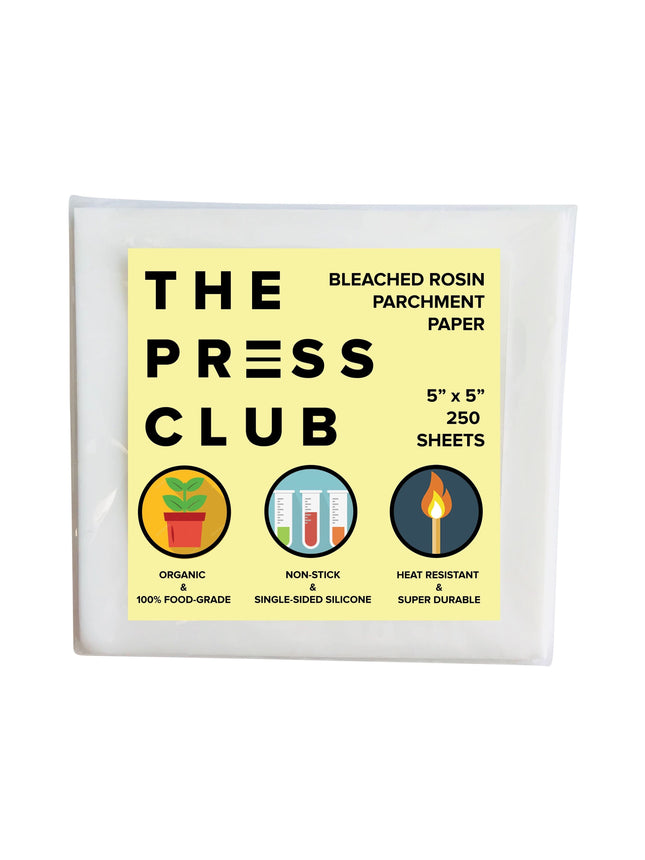

The Press Club The Press Club Premium Parchment
The Press Club Premium Parchment The Press Club premium parchment is made with a special paper blend specifically formulated for pressing. Press Club parchement paper has been lab-tested and proven to not only improve extraction quality but also increase yields. You cannot find this type of parchment paper anywhere else. 5" x 5"(250 Sheets), 10" x 10"(100 Sheets),6" x 12"(100 Sheets), 8"x 16"(100 Sheets), 23' x 15" Roll 250 Sheets 1-Side Coated Silicone 2x Thicker Than Store Bought Parchment To Prevent Tears 100% Food-Grade & FDA Approved Terpene & Heat Resistant (Up To 475°F) Highest Release Coating For Easy Collecting Satisfaction Guarantee & 365-Day Return Policy Made in USA
$34.94 - $41.94
-
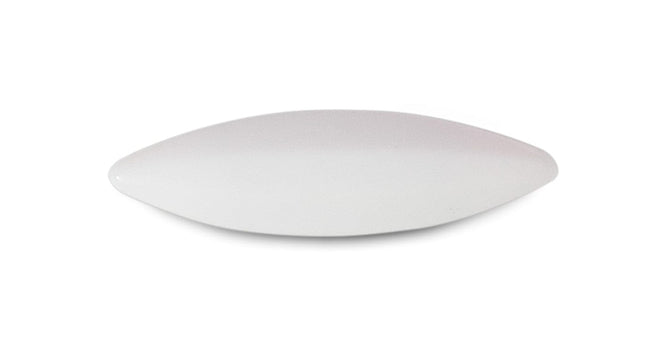

Magnetic PTFE Stirring Bar - L Style - 70mm
Magnetic PTFE Stir Bar - L Style - 70mm Reduce stir bar jumping with the contoured shape of this L Style Magnetic PTFE Stir Bar. Ideal for round-bottom flask stirring applications. This 70mm L Style Magnetic Stir bar is great for round-bottom flasks above 5 liters in capacity. With its PTFE coating this Magnetic Stir Bar carries excellent solvent and temperature compatibility for a variety of applications. Specifications: L Style 70mm Length Material: High-temperature PTFE
$21.01
-
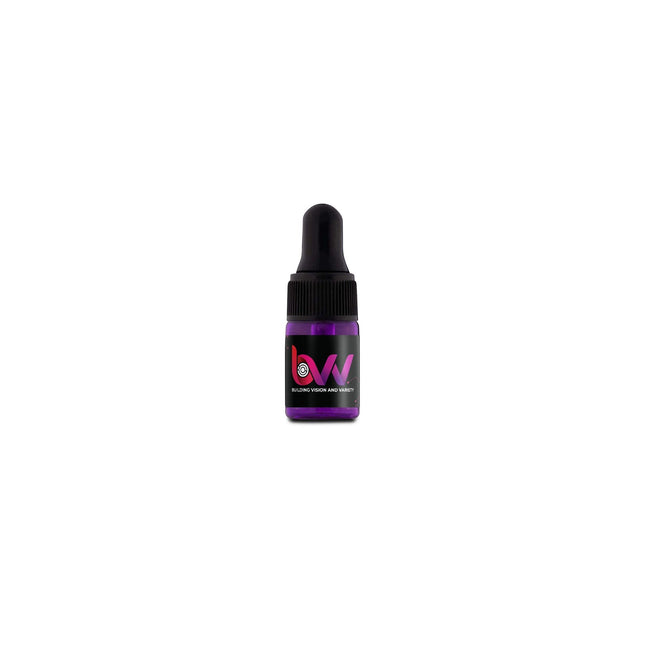

Terpenes Goji
BVV™ Terpenes Goji All sales are final. Orders can be refunded prior to fulfillment and shipping but once the order has been fulfilled and/or shipped, no refunds will be issued. Due to the hazardous nature of our product, we are unable to accept returns. BVV™ Terpenes are botanically derived terpenes enhanced with "nature-identical" artificial flavors. These flavors boost the natural flavor profile of the terpenes, providing the user with a more pleasant vaping experience. In order to provide complete transparency and elicit customer confidence, all ingredients are disclosed in the technical data sheet. BVV Goji Safety Data Sheet BVV Apple Jack Technical Data Sheet Goji: Goji OG has a unique fruity aroma. It will not only have soothing effects, but will give an uplifted, energetic focus. This sweet, red berry, licorice scented strain is a cross of Snow Lotus and Nepali OG, creating a sativa-dominant hybrid. FRAGRANCE: Spicy, herbal, sweet, licorice EFFECT: Uplifting, happy, hungry, euphoric Storage Requirements: Keep in the original container, lid securely tightened and away from heat, open flames, sunlight, combustible materials, and hot surfaces. Store below 15℃ (60℉). Improper storage can cause terpenes to degrade. Dilution: Terpenes must be diluted prior to use for flavor and effect (1-5% by total volume). Terpenes are oil soluble and mix well with plant extracts, coconut oil, and more. Handle With Care: Can cause skin irritation, do not ingest PRIOR to dilution.
$15.40 - $231.07
-
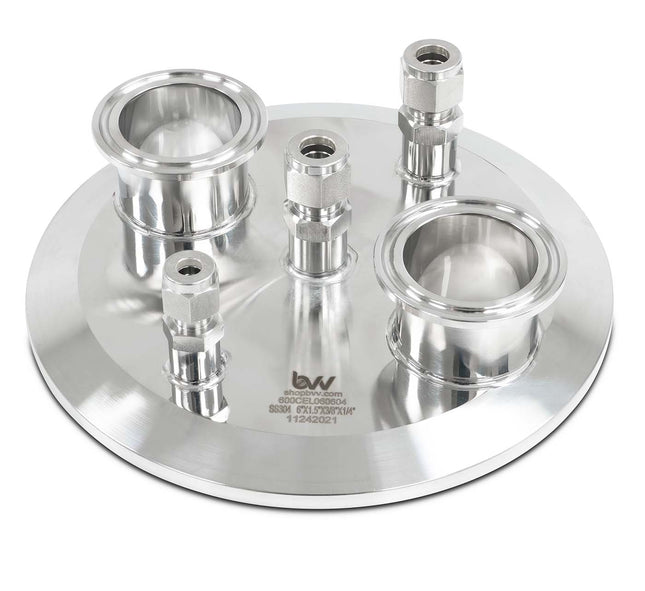
BVV Compression Extractor End Cap (2) 1.5" x (2) 3/8" Compression x 1/4" Compression
BVV Compression Extractor End Cap (2) 1.5" x (2) 3/8" Compression x 1/4" Compression This End Cap come with (2) 3/8" and (1) 1/4" Female Compression Connection and (2) 1.5" Tri-Clamp ferrule welded to the end cap. They allow the user to adapt and connect a threaded connection to the 1/4" port on a Tri-Clamp lid and the 1.5" Tri-Clamp Connection. These 3 connections are welded on a 6" Tri-Clamp End Cap. Specification Material: 304 Stainless Steel Connection Types: (2) 1.5" Tri-Clamp 6" Tri-Clamp (2) 3/8" and (1) 1/4" Female Compression Connection Standard: 3A
$203.06
-
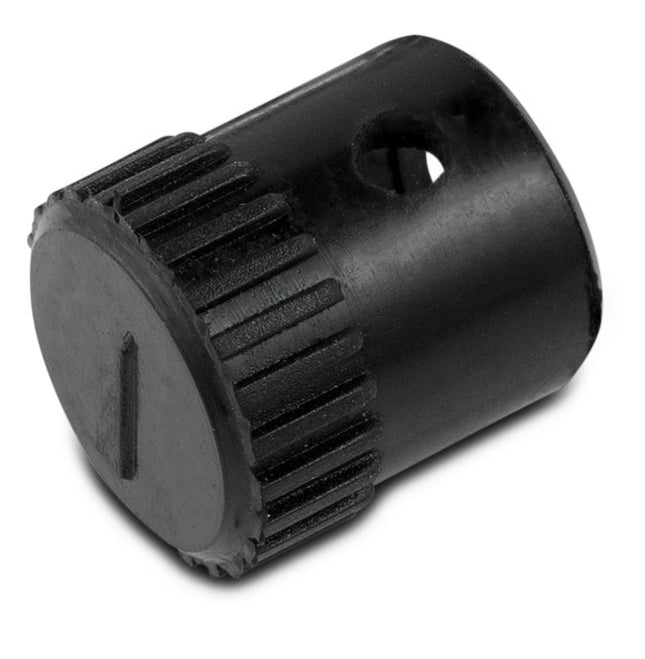
BVV™ Vacuum Oven Vent Release Stopper
Replacement Cap for eco and neo oven vacuum release knobs. Note the vent release may require the fitting to be greased to hold vacuum.
$11.20
-
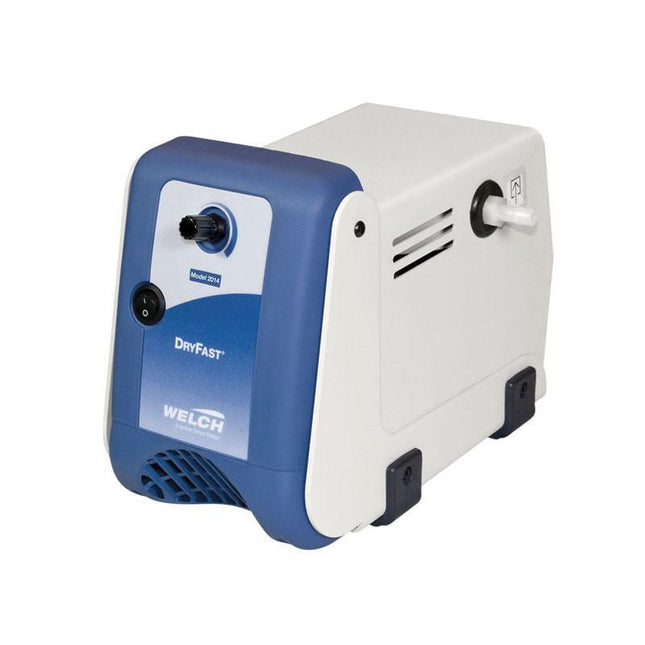
Welch Vacuum - Gardner Denver Welch DryFast Collegiate Diaphragm Pump 2014
DryFast Collegiate Diaphragm Pump 2014 ***Note: This item has a possible 1-2 week lead time depending on stock availability*** Product Details Chemical Resistant Oil-Free Tuneable Vacuum Welch DryFastTM PTFE Diaphragm Vacuum Pumps enable precise vacuum control for organic evaporations with exclusive Advanced Vapor Management (AVM). Oil-Free, portable, chemical resistant, 1 head diaphragm design simplifies maintenance. Choose from seven dry PTFE vacuum pump models with flows up to 70 L / min and adjustable vacuum down to 2 Torr. Economical DryFastTM vacuum pumps are perfect for tough lab applications. Model Number 2014 Applications Vacuum Filtration, SPE, Rotary Evaporations (volatile solvents <80oC B.P., volume <2 liters), pumping harsh vapors & gases, general laboratory vacuum Type Laboratory Vacuum Pump Free Air Displacement cfm (l/min.) @60Hz 1.2(35) Free Air Displacement m3/hr (l/min.) @50Hz 1.75(29) Ultimate Pressure 40(53) Maximum Vacuum 28.3 Motor Horsepower (watts) 1/5(150) Adjustable Vac. / Gas Ballast Yes Tubing Needed 1/4(7) Intake Thread NPT M14(1/8) Overall Dimensions LxWxH in. (cm) 12x7.0x8.3 (30.5x 17.8x21.1) Ship Weight 19(8.6) Shipping Carton Dimensions LxWxH in. (cm) 21x14x15 (52x35x37) Adjustable Vacuum Knob
$2,786.89
-
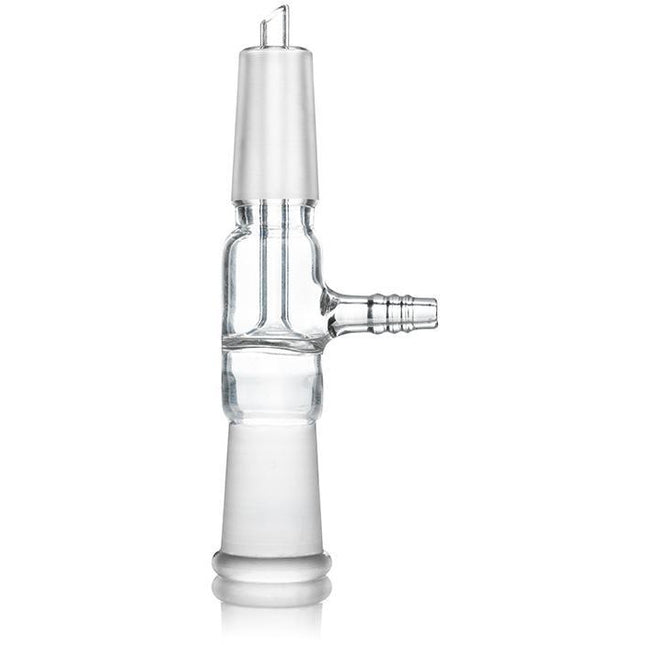
Straight Inlet Adapter with Hose Barb
Straight Inlet Adapter with Hose Barb This straight inlet adapter allows the user to connect a male and female 24/40 jointed connection and attached a flexible hose for vacuum if needed. *Notice to customers: All units are inspected for broken glassware or parts before leaving BVV™. If the unit arrives damaged (this does not include minor imperfections or scuffs in glassware), the customer MUST contact BVV™ within 72 hours from carrier delivery to file a claim. If the customer DOES NOT contact BVV™ within 72 hours from carrier delivery, then BVV™ cannot issue any replacement(s) or compensation for the item; a new purchase will need to be made for a replacement. **Glassware Safety Disclaimer: BVV™ is not responsible for failure of glassware which must be inspected before and after every use because it may eventually develop imperfections or damage through normal usage, mishandling, and stress caused by temperature variations. If an imperfection or damage is noted while inspecting the glassware DO NOT use the glassware because it can fail causing bodily harm or damage to the surrounding area.**
$42.01
-
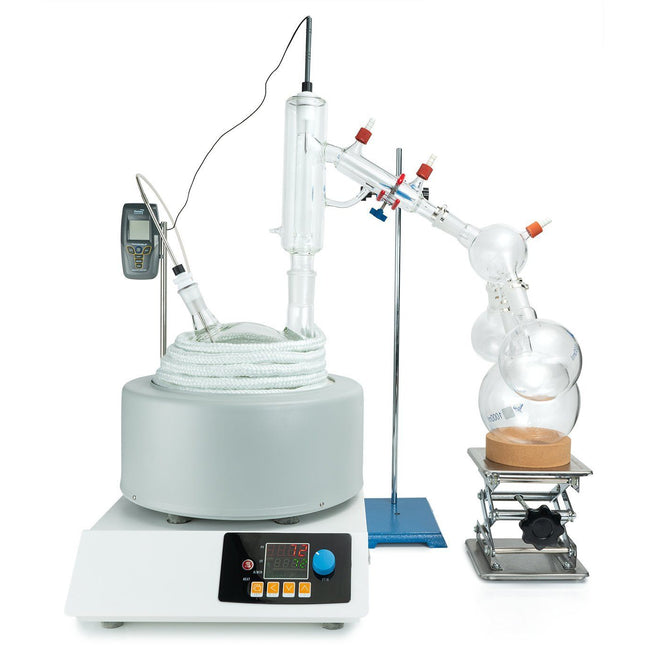

5L Short Path Distillation Kit with P5 Distillation Head
5L Short Path Distillation Kit with P5 Distillation Head This unit carries a 2 day lead time. The 5L Distillation Kit includes everything needed to perform distillation excluding the vacuum pump and chiller. This kit features our USA made P5 Distillation Head, as well as USA, made glass. This Kit is designed for high volume production with the highest quality components for precise, repeatable results time and again. This Kit Does NOT include a vacuum pump or chiller. Please see the below recommendations for both as well as recommended add-ons. Recommended Vacuum Pumps: Pro Series 11.3CFM Corrosion Resistant Two Stage Vacuum Pump (recommended option) Just Better 6 CFM 2 Stage Deep Vacuum Pump (economy option) Recommended Chillers: Polyscience 7 Liter MX Heated Circulator (economy option) Polyscience 7 Liter Refrigerated Circulator (premium option with chilling capability) Recommended Add-Ons: Bullseye Precision Vacuum Gauge (premium vacuum gauge for measuing depth) CT40 or CT80 Electronic Cold Trap (electronic cold trap, dry ice replacement) J-KEM Digital Vapor Temp Monitor (digital vapor temp monitor with data-logging capabilites) Specifications: Boiling Flask Size: 5L Receiving Flask Size: 2x 500mL, 1000mL Batch Capacity approximate: 1000-2500 grams Run time: 4 to 8 hours dependent upon material composition and throughput Distillation Temperature Range: 140-250C (Do not exceed 250C) Recommended Condenser Temperature: 40-50C This Kit Includes: Glass components: 5L Boiling Flask P5V6 Distillation Head Triple Neck Cow 2x 500mL Receiving Flask 1L Receiving Flask 120mm Glass Funnel Dewar cold trap Accessories: PTFE Magnetic Stir Bar Retriever 5 Pack of Metal Keck Clips Dow Corning High Vacuum Silicone Grease Tripod Stand 5L Digital Heating and Stirring Mantle 3-Finger Adjustable Clamp 0-77mm 6" x 6" Scissor Jack 500-1000mL Cork Stand 2x 24/40 ChemglassPTFE Thermometer Inlet Adapter 10ft of Gum Rubber Vacuum Hose 10ft of Silicone Chiller Hose 1/4" Vacuum Manifold Traceable Kangaroo Thermometer - Digital 10 Pack of Adjustable Stainless Steel Tubing Clamps Fiberglass Insulation Rope 10 Feet Distillation Quick Start Guide This guide gives basic quick start instructions for distillation systems. It is intended to provide a starting point for learning the process. Parameters should be adjusted to suit specific needs, Before beginning distillation, ensure the following steps have been taken: Vacuum Pump is in good working order. Pump should be run against dry load to allow internals to warm up. Oil should be clear. Cloudy or dark oil should be changed. All glass components are in good working order and ready to be assembled A winterization and degassing procedure has been done to prepare oil for distillation The unit's max internal temperature cannot exceed 380C. The recommended max set temperature should not exceed 250C Once all three of these steps have been completed, you are ready to begin distilling. Begin by placing stir bar in boiling flask and then load your material. This should be done using a funnel. A small amount of alcohol in the oil will give it a thinner consistency making it easier to transfer. Assemble all glassware and ensure each joint is properly greased. Do not use too much, as the vacuum pressure might pull some grease into the system. To ensure a full seal, spread grease in a circular motion by rotating glassware Attach circulator to condenser and set temperature to 50C. Allow circulator to reach temperature before beginning distillation. Connect vacuum pump to manifold. The manifold will allow you to isolate each individual component as well as let atmosphere into and out of the system. Connect receiving cow to cold trap. Connect cold trap to manifold. Connect vacuum gauge to manifold. At this point, ensure all connections are correct. Also ensure receiving cow is positioned to collect the first fraction in the far-left receiving flask. Circulator should be at its set temperature. Turn on vacuum pump to begin process. Turn on heat and set to 60C. Vacuum pump will begin to pull down and temperature will begin to rise. Watch the gauge to monitor vacuum pressure and stability. Start stir slower and increase speed with temperature. Once you are close to 60C, increase the temperature 20 degrees. Continue to raise the heat incrementally in 20-degree steps, increasing the set temperature as you near your set point. Increase temperatures incrementally until you reach 220C. You will see your first fraction somewhere between 180C and 190C or slightly before. This is the “heads” fraction. You will move to your second fraction when you see an increased reaction in the head, a slight color change toward golden, as well as a thickening of distillate. When this fraction hits, allow the distillate to “self-clean” the head for a minute or two then, rotate the cow to the middle receiving flask. Collect your “main body” fraction. You will see temps between 190-220C during this fraction. Continue to increase stirring speed as necessary. Reaction in the head may vary but it should never stop. As fluid level in the boiling flask decreases, increase stir speed. The final “tails” fraction is a mixture of the first and second fractions and should be saved for re-distillation later. Ideally, you want to turn the cow to the final flask before the tails fraction hits. The “tails” fraction has an obvious color change and will be darker than the “main body” fraction. You will see temps between 200-250C during this fraction. As fluid level in the boiling flask decreases even more, set stirring RPM higher (1000+ RPM). You may need to compensate with a bit more heat to finish of the final fraction as well. Once process is complete, stop heat, stop stir, and stop vacuum. Let atmosphere into the system. Be sure to properly store your distillate as exposure to air and light can cause oxidation. *Notice to Customers: All units are inspected for broken glassware or parts before leaving BVV™. If the unit arrives damaged (this does not include minor imperfections or scuffs in glassware), the customer MUST contact BVV™ within 72 hours from carrier delivery to file a claim. If the customer DOES NOT contact BVV™ within 72 hours from carrier delivery, then BVV™ cannot issue any replacement(s) or compensation for the item; a new purchase will need to be made for a replacement. BVV™ is not responsible for the failure of glassware which must be inspected before and after every use because it may eventually develop imperfections or damage through normal usage, mishandling, and stress caused by temperature variations. If an imperfection or damage is noted while inspecting the glassware DO NOT use the glassware because it can fail, which can cause bodily harm or damage to the surrounding area.
$3,080.98
-
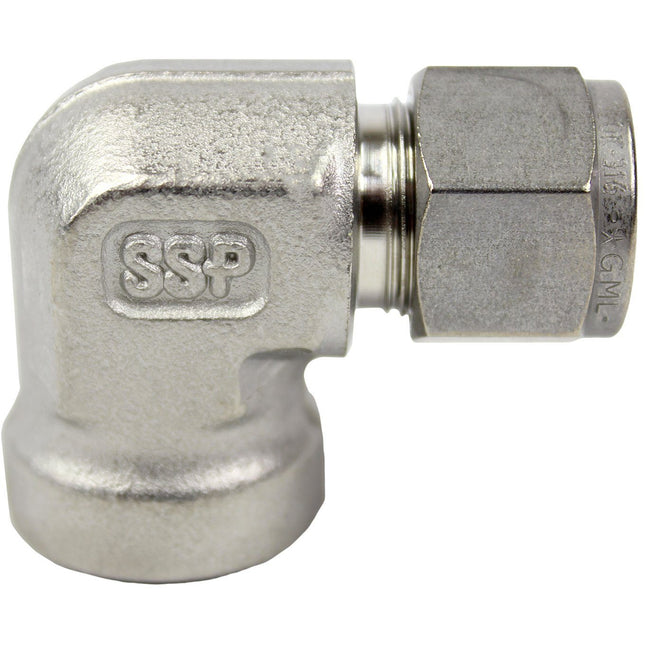

SSP Corporation Duolok Female Elbow
SSP - Female Elbow SSP Instrumentation TruFit® is manufactured from fully-traceable raw material to close tolerances and superior surface finishes. TruFit® provides optimal performance when installed in accordance with SSP’s recommendations and the design parameters appropriate for each type of connection – tapered thread, straight thread, and weld & braze. TruFit® components are cleaned in accordance with SSP documented work instructions using equipment calibrated to NIST standards with environmentally-safe and stable agents, ultrasonics, and heat/ temperature to remove all residual oil, grease, and loose particles. Stainless steel components are passivated to the requirements of MIL QQ-P-35 and ASTM A 967. ***Note: ALL NPT Threads REQUIRE the user to properly install the fitting by using a thread sealant to prevent leaks. BVV recommends GAS PTFE Tape Specifications Connection Type 1 Female NPT Connection Size 1 Specified by User Material 316 Stainless Steel ASTM A-276 and A-479 bar stock, A-182 forgings. Working Pressure (PSIG) 1/4" - 7750 ASME B31.3 SSP proudly makes Duolok®, TruFit®, FloLok® and hundreds of other products 100% in the USA! Dimensions A 1.17 in Bx 0.89 in By 0.89 in C 0.70 in D 0.60 in E 0.19 in G 9/16 in H 11/16 in P 1/4 in T 1/4 in
$11.20 - $35.01
-
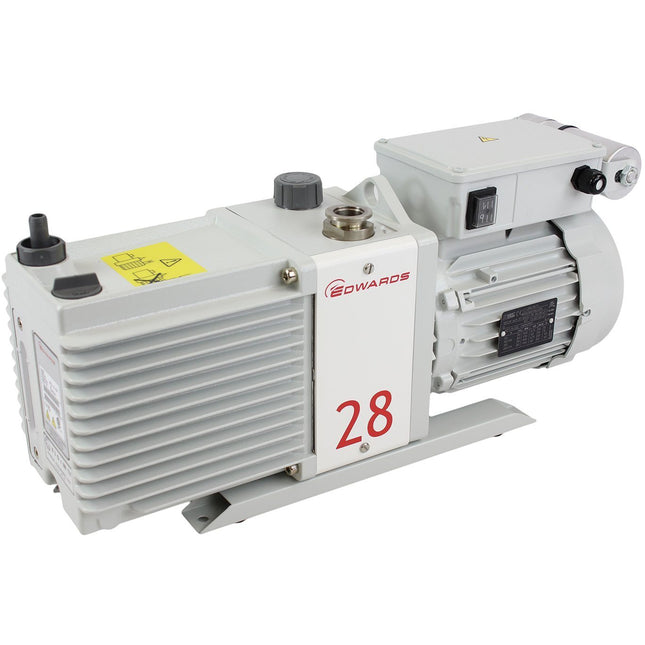
Edwards Edwards E2M28 21 CFM Dual-Stage High Capacity Vacuum Pump
Edwards E2M28 21 CFM Dual-Stage High Capacity Vacuum Pump ***Note: This item Will Ship by Freight only*** The EM range of oil‑sealed rotary pumps – renowned for their high ultimate vacuum, rapid pumping speed, quiet operation and ability to handle vapor – have become the industry standard for laboratory and light industrial applications. The pump is a freestanding unit with the drive provided through a flexible coupling by either a single‑phase or three‑phase (four pole) air cooled motor.Each EM pump is supplied with 2 x 1 liter of Ultragrade 19 oil, O ring and centering ring, two Allen keys and spares seal for oil drain and filter plugs. For PFPE prepared FX pumps Fomblin® to be ordered separately. Technology The motor is totally enclosed and is cooled by the motor-cooling fan which directs air along the motor fins. The motors are fitted with a thermal overload device. When the motor is too hot, the thermal overload device switches off the pump. The thermal overload device has an automatic reset; when the motor cools down, the device resets and the motor will restart.An oil pressure system lubricates the pump shaft bearing surfaces and rotor sealing faces. The pump has an oil distribution valve which prevents discharge of oil to the pump interior after the pump stops. The pumping chambers are air-tight, so this arrangement also prevents suckback unless the gas ballast valve is open.You can inspect the level and condition of oil in the oil box reservoir through the oil sight-glass. An oil filler-plug is fitted to the top of the oil box. The pump has two oil drain-plugs to allow either gravity oil drain or pressure oil drain. Features and Benefits The pump is designed for reliable, long‑term operation. Thermal overload device prevents overheating (single phase only). The drive is provided through a flexible coupling by a single‑phase or three‑phase (four pole) motor. The motors are totally enclosed and are cooled by the motor cooling fan. Full height O ring sealed oil sight glass for easy checking of oil level and condition. Large sight glass and operating oil range. IE3 energy efficient 3 phase motor used with E2M28. Edwards E2M28 21 CFM Dual-Stage High Capacity Vacuum Pump. The EM range of oil-sealed rotary pumps - renowned for its high ultimate vacuum, rapid pumping speed, quiet operation and ability to handle vapour - has become the industry standard laboratory and light industrial applications. The E2M28 pump is a two-stage, direct drive, sliding vane pump. The pump is oil sealed and designed for reliable, long-term operation in both laboratory and industrial environments. The pump is a freestanding unit with the drive provided through a flexible coupling by either a single-phase or three-phase (four-pole) motor. Specifications Displacement 50Hz 32.2 m3h-1 / 19 ft3min-1 60Hz 38.9 m3h-1 / 22.3 ft3min-1 Speed (Pneurop 6602) 50Hz 27.5 m3h-1 / 16.2 ft3min-1 60Hz 33.0 m3h-1 / 19.5 ft3min-1 Ultimate vacuum (total pressure) without gas ballast 1 x 10-3 mbar / 7.5 x 10-4 Torr with gas ballast 1.5 x 10-2 mbar / 1.1 x 10-2 Torr with Fomblin® 1 x 10-2 mbar / 7.5 x 10-3 Torr Inlet connection NW25 flange Outlet connection** Nozzle 15 mm external Ø removable from 3/4 in BSP tapped hole Max allowed pressure at outlet 0.5 bar gauge / 7 psig Max water vapour pumping rate – GB II 220 gh-1 Max inlet pressure for water vapour 30 mbar / 23 Torr Max water vapour pumping rate 0.7 kg h-1 Operating temperature range 13 – 40 °C Nominal rotation speed 1440 / 1720 rpm Motor power 50 Hz 0.75 kW Motor power 60 Hz 0.90 kW Power Connector 1-ph* IEC EN60320 C19 Weight 44 kg / 97 lbs Noise 57 dB(A) @ 50 Hz Oil capacity - max 1.5 litre Oil capacity - min 1.2 litre Recommended oil (supplied) Ultragrade 19 * Pumps listed with IEC connector only ** The FX are supplied with NW25 outlet connection ** POWER CORD NOT INCLUDED. RECOMMEND FOR CUSTOMER TO WIRE PUMP TO OUTLET WITH EXACT LENGTH. DO NOT USE EXTENSIONS** **RECOMMEND FOR CUSTOMER TO HAVE ELECTRICIAN WIRE PUMP TO OUTLET WITH EXACT LENGTH** Pump Warranty Information Customers using solvents such as stabilization resins (MinWax™, Gator Venom™ etc.), alcohol and other polar solvents must use the vacuum pumps in conjunction with a cold trap for evacuations in excess of 5 minutes. (Excludes Cactus Juice™) If the consumer is using the pump for prolonged periods of time exceeding 5 minutes we require that a cold trap is used or the pump warranty is void. These stabilization resins have the ability to break down the internal components of the pump that are plastic resulting in a seized motor voiding all warranties. When evacuation exceeds 5 minutes these solvents begin to vaporize and then re-condense in the vacuum pump reservoir. Once enough solvent re-condenses in the pump displacing the oil the plastic internal components may begin to warp, melt or seize. The use of a cold trap will condense the vapors prior to making their way to the vacuum pump preventing pump damage due to excessive use. Furthermore, Minwax Wood Hardener™ is not to be used with any vacuum pumps, EVER. (A seized motor will result within the first use.) To prevent these issues from happening to your process, change the Oil after each vacuum pump use, Even if the use time is only 5min.
$9,803.12 $8,682.77
-

Solvent Pro Series 18/35 Gasket
Solvent Pro Series 18/35 Gasket This is a replacement Gasket for 5, 10, 30, and 50L Solvent Pro Rotary Evaporators. This gasket fits an 18mm(0.71") Inner Diameter and 35mm(1.38") Outer Diameter joint. The gasket material is made of Silicone surrounded by a PTFE Envelope.
$18.21
-


Dipropylene Glycol (DPG) Low Odor
Dipropylene Glycol (DPG) - Low Odor - Technical Grade Dow® Chemical Product Dipropylene glycol (DPG) is a clear, colorless, and odorless liquid that is commonly used as a solvent, humectant, and emulsifier in a wide range of industries. It is a derivative of propylene glycol and consists of two propylene glycol molecules connected by an ether bond. Dipropylene glycol is less hygroscopic than propylene glycol and has a higher molecular weight, which makes it more viscous and less likely to evaporate quickly. In the fragrance and cosmetic industries, DPG is often used as a carrier for essential oils, perfumes, and other aromatic compounds, helping to dissolve and evenly distribute them in formulations. It helps improve the texture of creams, lotions, and other personal care products, while also enhancing their stability and shelf life. Due to its low toxicity, DPG is considered safe for use in food and cosmetic products in regulated amounts. However, as with many chemicals, prolonged or excessive exposure may lead to skin irritation or sensitivity in some individuals. As defined by OSHA Hazard Communication Standard, this product is not known to be a hazardous chemical. Applications and Uses for DPG: Fragrance and Perfume Industry: DPG is commonly used as a carrier or solvent for essential oils and fragrance compounds. It helps to dilute and stabilize fragrances, making them easier to apply and ensuring that the scent lasts longer. Cosmetics and Personal Care Products: DPG is a key ingredient in many personal care products such as lotions, creams, shampoos, deodorants, and soaps. It acts as a humectant (moisture-retaining agent), solvent, and emulsifier, helping to improve the texture, stability, and overall effectiveness of the product. Fog Solution: dipropylene glycol is frequently found in fog juice / liquid, where it works as a base to create heavy low hanging fog vapor. Where as propylene glycol produces a lifting lighter fog vapor that tends to go towards the ceiling. Our low odor formula make it perfect for indoor fog applications. Pharmaceuticals: In the pharmaceutical industry, dipropylene glycol is used as a solvent in medications, especially in liquid formulations like oral solutions, syrups, and injectable drugs. It helps dissolve active ingredients and stabilize the formula. Industrial Applications: DPG is used in the manufacture of paints, coatings, cleaning agents, and lubricants. It functions as a solvent and helps improve the consistency and spreadability of these products. Antifreeze and De-icing Products: While less common than propylene glycol, dipropylene glycol can also be used in some antifreeze and de-icing formulations due to its low freezing point and excellent solvency properties. Food and Beverages: Though not as widely used as propylene glycol, DPG can be found in certain food and beverage products, where it serves as a solvent or stabilizer for flavorings, colorants, and other additives. Textile and Leather Industry: DPG is used as a softener and finishing agent for textiles and leather products, contributing to a smooth texture and enhancing the durability and quality of the materials. What are some of the fragrance products you can make with diproplene glycol (DPG)? Perfumes and colognes Skin care products (creams, lotions, body oils, sun-care products) Deodorants and antiperspirants (roll-on, stick deodorants) Hair care products (shampoos, conditioners, styling, coloring products) Shaving products (creams, foams, gels, after-shave lotions) Bath and shower products Dipropylene Glycol Certificate of Analysis COA Dipropylene Glycol Safety Data Sheet SDS
$25.21 - $1,949.42
-


The Press Club The Press Club 4" x 7" ROSIN BAGS
4" x 7" ROSIN BAGS The Press Club brings science to the art of rosin pressing. We pride ourselves in making the toughest and strongest rosin bags on the market. After years of research and lab testing, all our rosin bags are now made with our proprietary pink stitch and come with a ZERO BLOWOUT GUARANTEE™. If you ever get one, we'll replace the bag. It's that simple. Available in 25, 37, 50, 75, 90, 120, 160 and 220 micron. 4” x 7” Inch 25-Pack Pre-Flipped Inside-Out 100% Food-Grade Nylon Solvent & Boil Resistant High Pressure Resistance (Over 20 Tons) High Heat Resistance (Up To 375° F) Reusable Over 5x (Simply Wash With Alcohol) Covered By The Press Club’s Zero Blowout Guarantee Satisfaction Guarantee & 365-Day Return Policy Made In USA General Micron Guideline: Dry Sift & Bubble (5, 10, 15, 25, 37, 50) | Flower (75, 90, 120, 160, 220)
$41.94
-
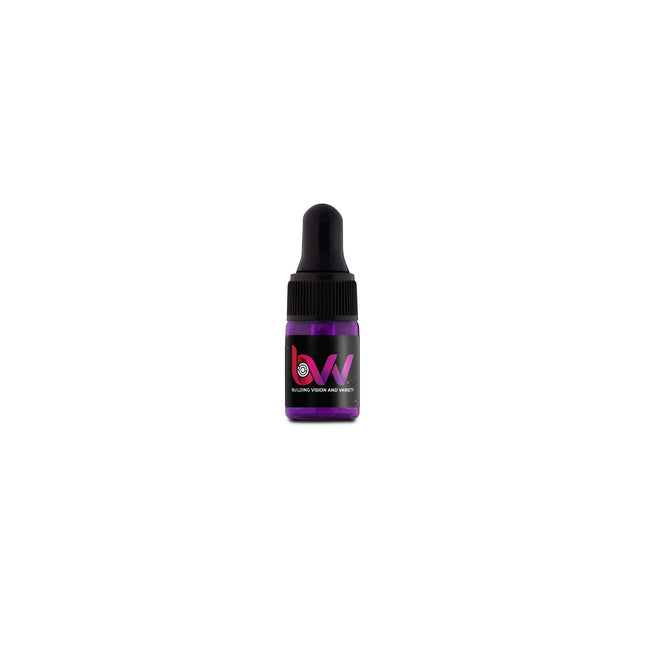

Terpenes Indica
BVV™ Terpenes Indica All sales are final. Orders can be refunded prior to fulfillment and shipping but once the order has been fulfilled and/or shipped, no refunds will be issued. Due to the hazardous nature of our product, we are unable to accept returns. BVV™ Terpenes are botanically derived terpenes enhanced with "nature-identical" artificial flavors. These flavors boost the natural flavor profile of the terpenes, providing the user with a more pleasant vaping experience. In order to provide complete transparency and elicit customer confidence, all ingredients are disclosed in the technical datasheet. BVV™ Indica Safety Data Sheet Indica is known for its relaxing and therapeutic qualities in the body. Indica's are something people often turn to when suffering from pain or they lack the ability to fall asleep. FRAGRANCE: Earthy and Skunky. EFFECT: Relaxing body high that can reduce pain, assist with sleep, and increase appetite. Storage Requirements: Keep in the original container, lid securely tightened and away from heat, open flames, sunlight, combustible materials, and hot surfaces. Store below 15℃ (60℉). Improper storage can cause terpenes to degrade. Dilution: Terpenes must be diluted prior to use for flavor and effect (1-5% by total volume). Terpenes are oil soluble and mix well with plant extracts, coconut oil, and more. Handle With Care: Can cause skin irritation, do not ingest PRIOR to dilution.
$15.40 - $231.07
-
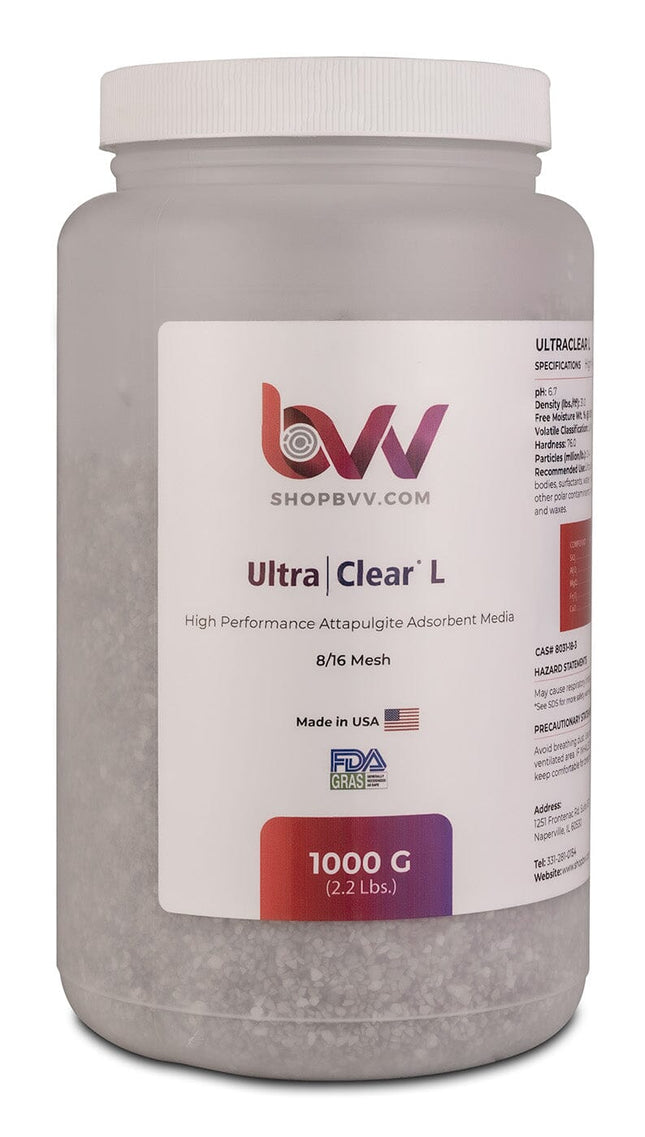

Ultra Clear L - Granular High Performance Bentonite for Bleaching & Decolorizing Edible Oils
Ultra:Clear® L 8/16 Mesh Made in USA, Food Grade Certified Ultra-Clear® L effectively removes color bodies, surfactants, water, free fatty acids, organic oxides, and other polar contaminants from a wide range of oils, liquids, and waxes. It is the Largest particle size in the Ultra-Clear product line. UltraClear® L is a unique, naturally occurring attapulgite that has been thermally processed to provide hard, durable granules that won’t swell or breakdown in the presence of water. All Ultra-Clear products are classified as processing aids andhave Generally Recognized As Safe (GRAS) status from theFood and Drug Administration (FDA). At BVV™ we recommend 200g per lb. of biomass. We also use this media with layering techniques & can be used with BVV™ Silica Gel and BVV™ Neutral Activated Alumina for a sugar in the oven finish! Ultra-Clear® is manufactured in 4 granule sizes, 8/16, 16/30, 30/60 & 60/90 mesh sizes. See the technical data sheet for more information from the manufacturer. Ultra:Clear® L Food Grade Certificate Ultra:Clear® L Technical Data Sheet Ultra:Clear® L Safety Data Sheet
$21.01 - $3,010.96
-
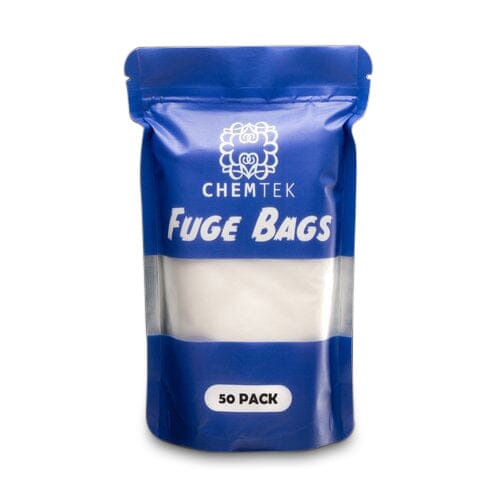
ChemTek ChemTek Large Fuge Bags - 50 Pack
ChemTek Large Fuge Bags - 50 Pack Centrifuge bags used for separations. Specifications: Size: 50-Pack Dimensions: H: 7” W: 6.5” Micron Size: 25 Micron Material: Food Grade Nylon
$70.02
-
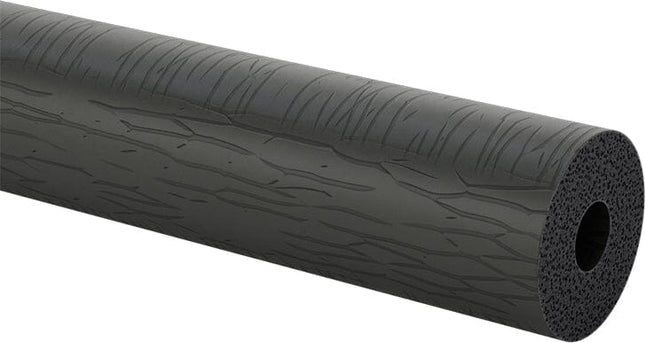

Foam Insulation for Hose and Tubing - 6 Feet
Foam Insulation for Hose and Tubing - 6 Feet This foam insulation is good for silicone tubing, stainless steel braided hosing, compression hard line tubing, and more! The inner diameter of the foam can be 3/8", 1/2", or 5/8" and must be selected in the drop down menu. This should correspond with the outer diameter of the hose that you want to insulate. The 3/8" option will slide on your hose or tube while the 1/2" and 5/8" options have a taped seam. All options come in 6' lengths. Sizing Chart: Foam Insulation Size: 3/8" 1/2" 5/8" For Compression Tube Size 3/8" 1/2" - For Stainless Steel Braided Hose Size 3/8" * 1/2" - For Silicone Tube Size 1/4" 3/8" 1/2" Composition Nitrile, PVC Flame/Smoke Rating 25/50 Height 1.375 Insulation Nominal I.D. 3/8" Length 72 R-Value R4.1 Temperature Range -297°F to 220°F (-182.78°C to 104.44°C) Country of Origin USA * The 3/8" foam does not have a seam and cannot be easily slid over stainless steel braided hose with permanent end fixtures.
$47.62 - $63.02
-
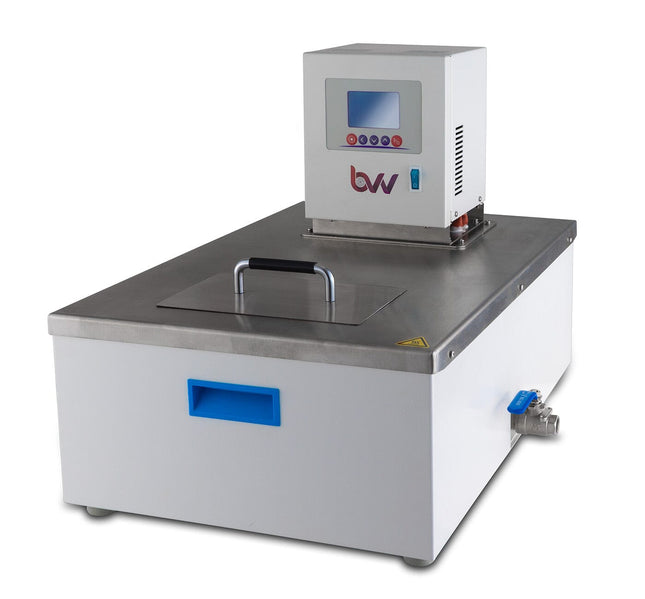

19 Liter Neocision Heated Circulator - ETL Listed
BVV™ Neocision 19 Liter Heated Circulator - ETL Listed The Neocision 19 Liter Heated Circulator - ETL Listed brings very stable temperature control and lab grade quality at a great price. This refrigerated circulator has a durable powder coated exterior with a stainless steel top, stainless steel interior and a large control head with digital display. This high powered laboratory heater is great for extraction or distillation applications! Key Features: ETL Certified Digital Control Head with Large Display Corrosion Resistant Stainless Steel Top and Interior 220°C Max Temperature Rubber Feet for Vibration Dampening and Noise Reduction 19L Internal Reservoir Capacity Small Table Top Design Side drain valve for water bath 1/2" Male NPT attachments Technical Indicators Index NEO-19H Power Supply Voltage AC220V 60Hz (NEMA L6-30 Plug) Input Power (W) 4100 Temperature Control Range (C°) RT+20 ~ 220 C° Temperature Fluctuation (C°) ±0.1 Pump Flow (Lmin) 10(water ) Filling Volume (L) 22.5 Bath Opening Size (mm) 200 x 120 Dimensions (W x D x H) (mm) 330 x 300 x150
$4,481.43
-
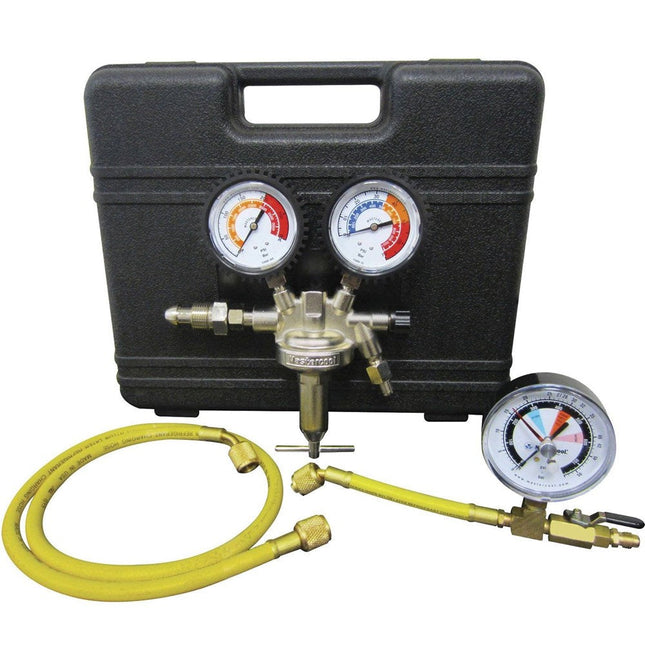
Mastercool Mastercool Nitrogen Pressure Regulator Kit
Mastercool Nitrogen Pressure Regulator Kit Product Description Mastercool’s new nitrogen regulator is specifically designed to meet the specifications of HVAC/R and automotive A/C systems. This single stage nitrogen regulator is used to test systems for leaks when they do not contain refrigerant. 1/4” SAE flare outlet port, with control valve, to keep pressure on the regulator at all times T-Handle for ease of pressure adjustment 63 mm (2 1/2”) gauges with guards High pressure gauge 4400 psig (300 bar) Low pressure gauge 1000 psig (70 bar)
$266.08
-
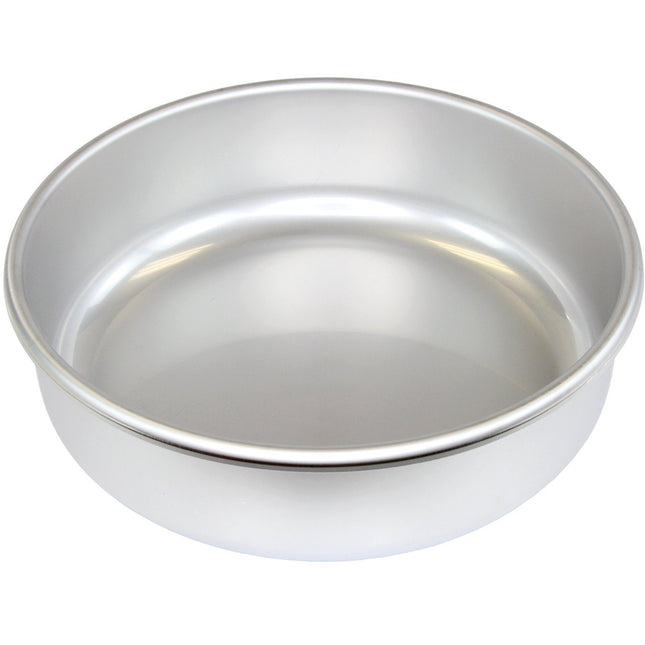
1 Gallon Flat Stainless Steel - POT ONLY
1 Gallon Flat Stainless Steel - POT ONLY This is a replacement part for the following Vacuum Chambers: Best Value Vacs 1 Gallon Flat Stainless Steel Vacuum and Degassing Chamber SVac 1 Gallon Flat Stainless Steel Vacuum Chamber Dimensions: 3" Tall x 10.25" Diameter Material: 304 Stainless Steel
$44.81
-
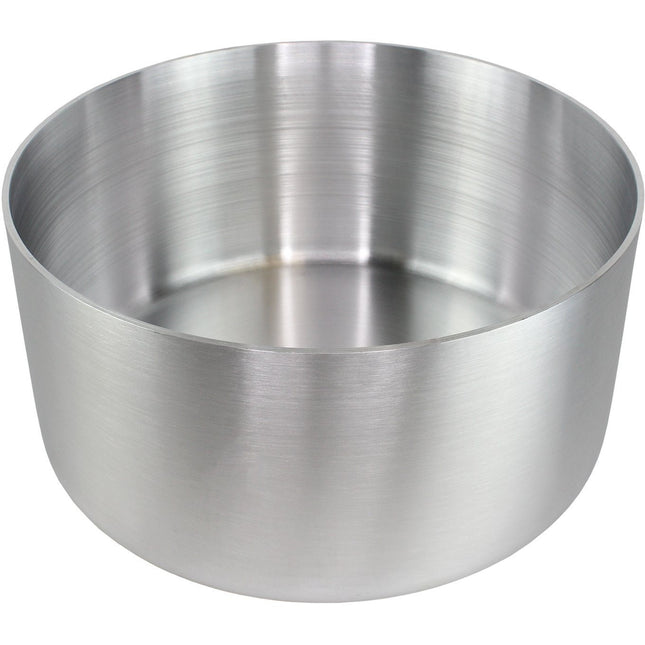
7 Gallon Aluminum - POT ONLY
7 Gallon Aluminum - POT ONLY This is a replacement part for the following Vacuum Chambers: Best Value Vacs 7 Gallon Aluminum Vacuum and Degassing Chamber Dimensions: 8" Tall x 16" Diameter Material: 3004 Aluminum
$151.25
-
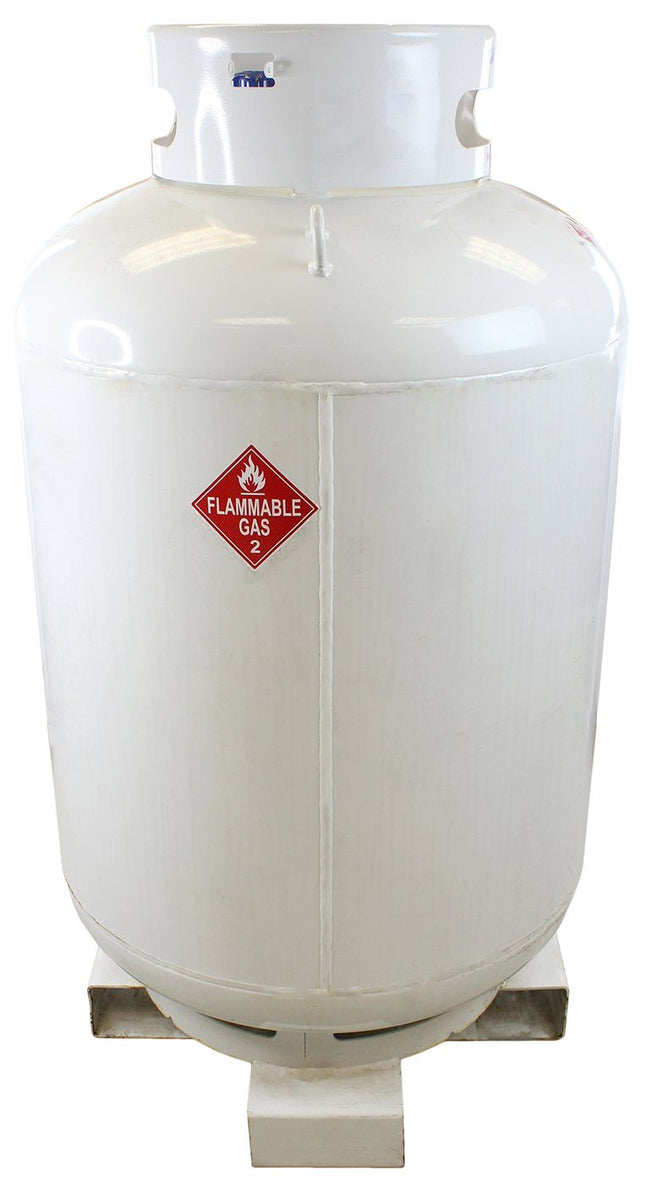
Half Ton - High Purity USA 50/25/25% N-Butane/Iso-Butane/Propane TRI-Blend - 99.5% Guaranteed
Half Ton - High Purity USA 50/25/25% N-Butane/Iso-Butane/Propane TRI-Blend - 99.5% Guaranteed DISCLAIMER(S): This unit is intended for LEGAL purposes only, to be used in accordance with local laws and ordinances. Use only in WELL VENTILATED AREAS! Notice: This item will ship via Freight ONLY. This tank requires a CGA 510 fitting - Sold Separately BVV™ always recommends distillation of every solvent before use. *Actual liquid weight is 482LB California now prohibits the retail sale of any Non-Odorized butane in quantities larger than 150ml. If you are not a retail purchaser you can call in to place an order. Permitted Sales Include the Following: Medical Collectives or Cooperatives operating under CA Health & Safety Code Section 11362.775 Persons licensed to perform volatile solvent extraction activity under CA Bus & Prof Code Division 10 Manufacturers, wholesalers, resellers, or retailers solely for the purpose of resale High purity 50/25/25% N-Butane/Iso-Butane/Propane TRI-Blend is USA sourced, and guaranteed to be 99.5% pure. This instrument grade solvent helps to produce a higher quality extract by reducing mystery oils and contaminants. Solvent comes in a DOT refillable LP tank with liquid withdrawal valve (Diptube). This product is clean, colorless and odorless. *Actual liquid weight is 482LB Due to FAA regulations, solvent tanks cannot be safely transported via means other than ground. Any order that has solvent will not be shipped in an expedited fashion. If an order with solvent is combined with any other items and chosen to be expedited, that entire order will ship via UPS Ground/Freight. We will not split up any orders and ship them separately. If a customer is wanting to expedite specific items and order solvent, 2 separate orders (1 for the solvent and 1 for the expedited items) will need to be placed in order to do so. Solvents do not ship to Hawaii, Puerto Rico, or any other US Territory outside of the contiguous 48 States. Shipping Solvent to Alaska may ONLY ship via freight and will be required to travel through Canada. We have this policy in place to ensure safety when transporting solvents, and to prevent any issue with shipping times for our customers. Chemical Formula: C₄H₁₀ + C3H8 Molecular Weight: 58.12 g/mol & 44.10 g/mol CAS Registry Number: 106-97-8 & 74-98-6 & 75-28-5 Appearance Colorless Odor: Faint Petroleum Density N/A Boiling Point: N/A Solubility in water: Low Solubility GHS Pictograms: GHS Signal Word: Danger GHS Hazard Statements: H220, H280 GHS Precautionary Statements P210, P377, P381, P403, P410+P403 UN Identification Number: 1965 Proper Shipping Name: Hydrocarbon Gas Mixture, liquefied, n.o.s. Transport Hazard Class: 2.1 Packing Group: None DOT Placard: Tri-Blend Certificate of Conformance (COC) and Certificates of Analysis (COA's) Tri-Blend Safety Data Sheet (SDS)
$4,341.38
-
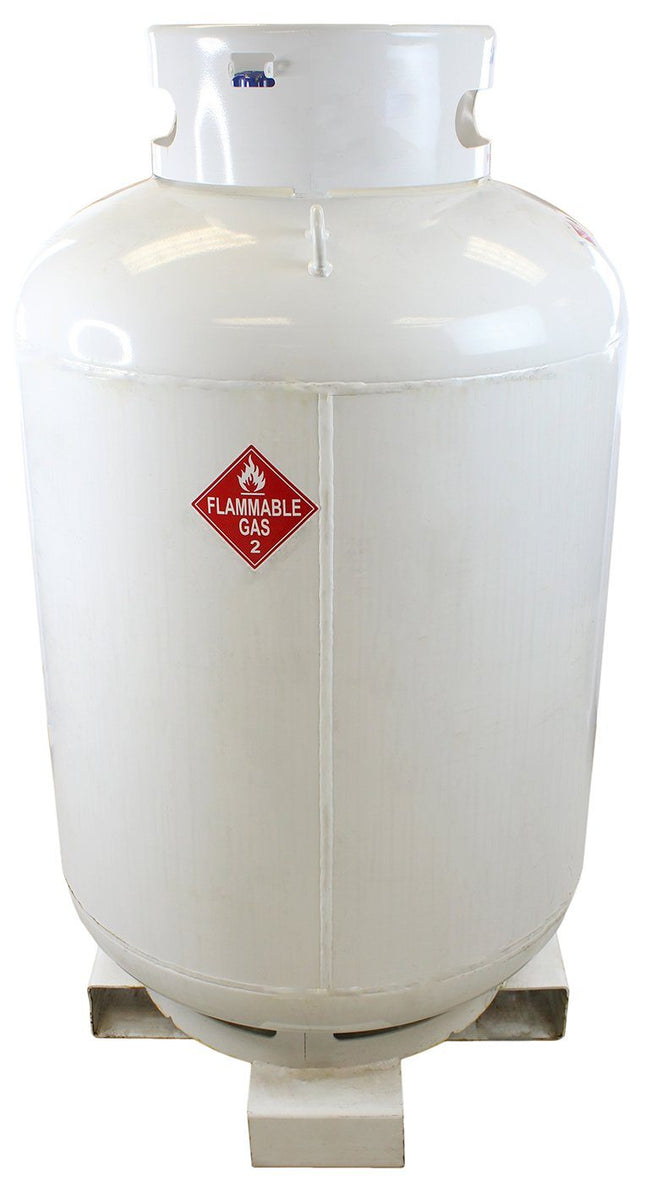
Half Ton - High Purity USA 70/30% N-Butane/Propane Blend - 99.5% Guaranteed
Half Ton - High Purity USA 70/30% N-Butane/Propane Blend - 99.5% Guaranteed DISCLAIMER(S): This unit is intended for LEGAL purposes only, to be used in accordance with local laws and ordinances. Use only in WELL VENTILATED AREAS! Notice: This item will ship via Freight ONLY. This tank requires a CGA 510 fitting - Sold Separately BVV™ always recommends distillation of every solvent before use. *Actual liquid weight is 483LB California now prohibits the retail sale of any Non-Odorized butane in quantities larger than 150ml. If you are not a retail purchaser you can call in to place an order. Permitted Sales Include the Following: Medical Collectives or Cooperatives operating under CA Health & Safety Code Section 11362.775 Persons licensed to perform volatile solvent extraction activity under CA Bus & Prof Code Division 10 Manufacturers, wholesalers, resellers, or retailers solely for the purpose of resale High purity 70/30% N-Butane/Propane is USA sourced, and guaranteed to be 99.5% pure. This instrument grade solvent helps to produce a higher quality extract by reducing mystery oils and contaminants. Solvent comes in a DOT refillable LP tank with liquid withdrawal valve (Diptube). This product is clean, colorless and odorless. *Actual liquid weight is 483LB Due to FAA regulations, solvent tanks cannot be safely transported via means other than ground. Any order that has solvent will not be shipped in an expedited fashion. If an order with solvent is combined with any other items and chosen to be expedited, that entire order will ship via UPS Ground/Freight. We will not split up any orders and ship them separately. If a customer is wanting to expedite specific items and order solvent, 2 separate orders (1 for the solvent and 1 for the expedited items) will need to be placed in order to do so. Solvents do not ship to Hawaii, Puerto Rico, or any other US Territory outside of the contiguous 48 States. Shipping Solvent to Alaska may ONLY ship via freight and will be required to travel through Canada. We have this policy in place to ensure safety when transporting solvents, and to prevent any issue with shipping times for our customers. Chemical Formula: C₄H₁₀ + C3H8 Molecular Weight: 58.12 g/mol & 44.10 g/mol CAS Registry Number: 106-97-8 & 74-98-6 Appearance Colorless Odor: Faint Petroleum Density N/A Boiling Point: N/A Solubility in water: Low Solubility GHS Pictograms: GHS Signal Word: Danger GHS Hazard Statements: H220, H280 GHS Precautionary Statements P210, P377, P381, P403, P410+P403 UN Identification Number: 1965 Proper Shipping Name: Hydrocarbon Gas Mixture, (Butane/Propane) liquefied, n.o.s. Transport Hazard Class: 2.1 Packing Group: None DOT Placard: Dual Blend Certificate of Analysis (COA) Dual Blend Safety Data Sheet (SDS)
$4,341.38
-
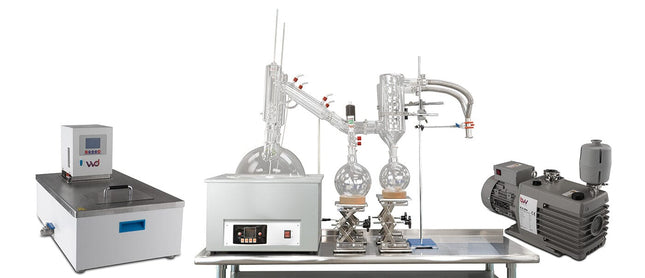

Neocision 20L Neocision Dual Short Path Distillation Turnkey System
20L Neocision Dual Short Path Distillation Turnkey System This unit carries a 2 day lead time. (Note: This kit does NOT include the stainless steel table.) The 20L Neocision Distillation Turnkey Setup features our Dual USA made P10V6 Distillation Heads. Every component in this distillation kit is made for precision, throughput, and repeatable results. You will also receive Dual Dewar Style Ribbed Glass Cold Traps to keep all volatiles and solvents out of your vacuum system. This Turnkey Setup gives you everything needed to perform distillation at the highest level. The 20L Neo Kit Includes: 20L Neocision Kit with glassware, labware, and Dual P10V6 Distillation Heads. BVV 15 Liter Advanced Digital Heated Circulator Choice of Vacuum Pump KF-25 Bellow Y Manifold Dual Ribbed Dewar Style Glass Cold Trap Non-Mercury Glass Thermometers 20L Digital Heating and Stirring Mantle Distillation Quick Start Guide This guide gives basic quick start instructions for distillation systems. It is intended to provide a starting point for learning the process. Parameters should be adjusted to suit specific needs, Before beginning distillation, ensure the following steps have been taken: Vacuum Pump is in good working order. Pump should be run against dry load to allow internals to warm up. Oil should be clear. Cloudy or dark oil should be changed. All glass components are in good working order and ready to be assembled A winterization and degassing procedure has been done to prepare oil for distillation The unit's max internal temperature cannot exceed 380C. The recommended max set temperature should not exceed 250C Once all three of these steps have been completed, you are ready to begin distilling. Begin by placing stir bar in the boiling flask and then load your material. This should be done using a funnel. A small amount of alcohol in the oil will give it a thinner consistency making it easier to transfer. Assemble all glassware and ensure each joint is properly greased. Do not use too much, as the vacuum pressure might pull some grease into the system. To ensure a full seal, spread grease in a circular motion by rotating glassware Attach circulator to condenser and set temperature to 50C. Allow circulator to reach temperature before beginning distillation. Connect vacuum pump to manifold. The manifold will allow you to isolate each individual component as well as let atmosphere into and out of the system. Connect receiving cow to cold trap. Connect cold trap to manifold. Connect vacuum gauge to manifold. At this point, ensure all connections are correct. Also ensure receiving cow is positioned to collect the first fraction in the far-left receiving flask. Circulator should be at its set temperature. Turn on vacuum pump to begin process. Turn on heat and set to 60C. Vacuum pump will begin to pull down and temperature will begin to rise. Watch the gauge to monitor vacuum pressure and stability. Start stir slower and increase speed with temperature. Once you are close to 60C, increase the temperature 20 degrees. Continue to raise the heat incrementally in 20-degree steps, increasing the set temperature as you near your set point. Increase temperatures incrementally until you reach 220C. You will see your first fraction somewhere between 180C and 190C or slightly before. This is the “heads” fraction. You will move to your second fraction when you see an increased reaction in the head, a slight color change toward golden, as well as a thickening of distillate. When this fraction hits, allow the distillate to “self-clean” the head for a minute or two then, rotate the cow to the middle receiving flask. Collect your “main body” fraction. You will see temps between 190-220C during this fraction. Continue to increase stirring speed as necessary. Reaction in the head may vary but it should never stop. As fluid level in the boiling flask decreases, increase stir speed. The final “tails” fraction is a mixture of the first and second fractions and should be saved for re-distillation later. Ideally, you want to turn the cow to the final flask before the tails fraction hits. The “tails” fraction has an obvious color change and will be darker than the “main body” fraction. You will see temps between 200-250C during this fraction. As fluid level in the boiling flask decreases even more, set stirring RPM higher (1000+ RPM). You may need to compensate with a bit more heat to finish of the final fraction as well. Once process is complete, stop heat, stop stir, and stop vacuum. Let atmosphere into the system. Be sure to properly store your distillate as exposure to air and light can cause oxidation. ***Note: This entire setup will ship via motor freight.*** *Notice to Customers: All units are inspected for broken glassware or parts before leaving BVV™. If the unit arrives damaged (this does not include minor imperfections or scuffs in glassware), the customer MUST contact BVV™ within 72 hours from carrier delivery to file a claim. If the customer DOES NOT contact BVV™ within 72 hours from carrier delivery, then BVV™ cannot issue any replacement(s) or compensation for the item; a new purchase will need to be made for a replacement. BVV™ is not responsible for the failure of glassware which must be inspected before and after every use because it may eventually develop imperfections or damage through normal usage, mishandling, and stress caused by temperature variations. If an imperfection or damage is noted while inspecting the glassware DO NOT use the glassware because it can fail, which can cause bodily harm or damage to the surrounding area.
$18,205.80 - $23,807.59
-
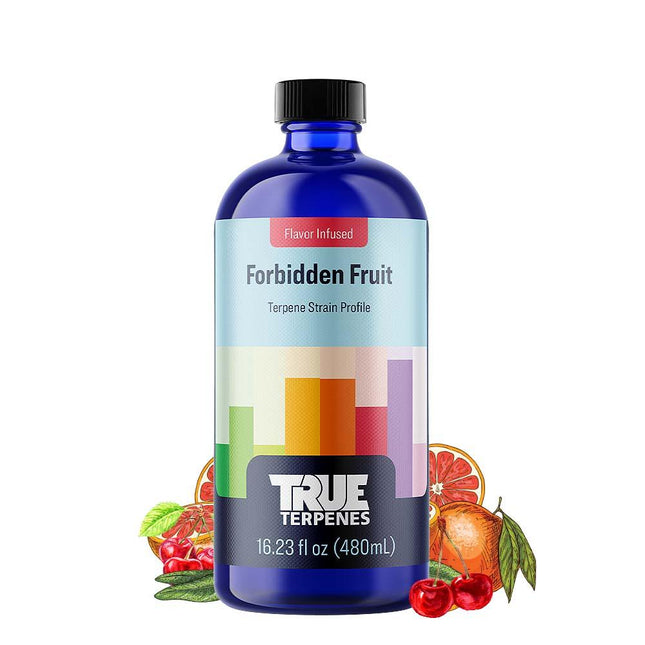

True Terpenes True Terpenes Forbidden Fruit
True Terpenes Forbidden Fruit Fragrance: Cherry Blossom Grape Fruit Cedar Floral Musky Effects: Relaxing Soothing Uplifting Forbidden Fruit delivers on its name. Created by crossing two flavor forward cultivars Cherry Pie and Tangie, this profile is temptingly good. Storage Requirements: Keep in original container, lid securely tightened and away from heat, open flames, sunlight, combustible materials and hot surfaces. No Smoking. Store in a cool dry place. Improper storage can cause terpenes to degrade. Dilution: Terpene Strain & Flavor-Infused Strain Profiles, Effects-Based Terpene Profiles & Terpene Flavors:The Terpene products above must be diluted prior to use. (1-5% by total volume). Terpenes are oil soluble and mix well with plant extracts, coconut oil, and more. Viscosity Extract Modifier: The Terpene product above must be diluted prior to use. (1-3% by total volume). Terpenes are oil soluble and mix well with plant extracts, coconut oil, and more. Handle With Care: Can cause skin irritation, do not use PRIOR to dilution. Forbidden Fruit-Specific Certificates: Product Specification Certificate of Analysis Safety Data Sheet Food Safety Company-Specific Certificates: ISO 9001:2015 GMP Certification FSSC 22000
$170.15 - $3,151.00
-
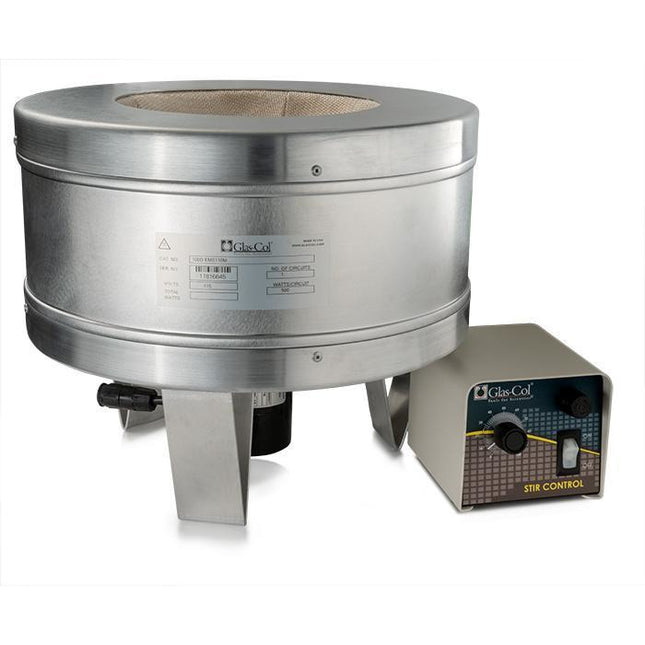
Glas-Col Glas-Col Stirmantle
2L Glas-Col Stirmantle Glas-Col offers two types of StirMantles: Electromagnetic (50 to 750 rpm) and Motor Driven (100 to 1850 rpm). The maximum rpms available for each type depends on the viscosity of the solution being heated. Electromagnetic StirMantles are typically used with aqueous solutions like water, while the Motor Driven units use a powerful magnet for higher viscous solution like oils. StirMantles withstands 400°C internal operating temperature. EMS series include the heating mantle, speed control and stir-bar. WARNING: chemical spillage, overheating, overloading, and general misuse will greatly reduce service life! Note: The temperature probe this mantle comes with can only be used with a thermowell. If you are using it with BVV™ glassware you will need to add SKU: TK1/4-12 or TK1/4-18 depending on what mantle size is selected.
$1,470.47 $840.27
-
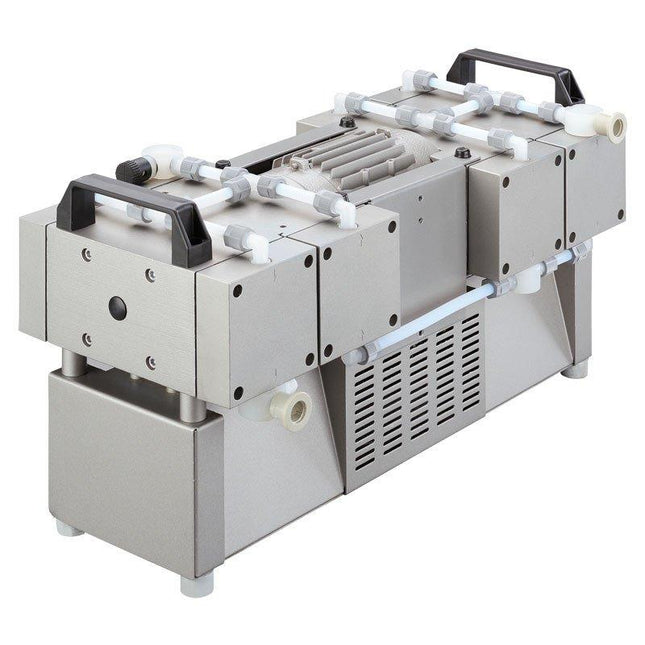
Welch Vacuum - Gardner Denver Welch 6.1 cfm Full Chemical-Resistant 8-Head Diaphragm Pump
Welch 6.1 cfm Full Chemical-Resistant 8-Head Diaphragm Pump The Welch 6.1CFM Full Chemical-Resistant 8-Head Diaphragm Pump is the ideal choice for 50L Rotary Evaporators and large oven systems. This high capacity, full chemical resistant pump gives users the ability to vac down large capacity spaces quickly, efficiently, and cleanly without worrying about contamination of pump oil. The inner diaphragm is lined with PTFE making it highly chemical resistant and long lasting. It is one of the quietest and cleanest running vacuum pumps on the market. Key Features: Fully Chemical-Resistant Oil-less diaphragm style vacuum pump High capacity vacuum capability Specifications: Electrical Requirements: 110v 60Hz single phase Pumping Rate: 6.1cfm / 174L/min Gasket Material: All-PTFE Ultimate Vacuum level: 6 torr / 8 mbar Maximum Vacuum: 29.9 inHg Inlet / Outlet: KF16 Flange Adjustable vac. / gas ballast: No Unit dimensions (LxWxH in): 21x10x12 in Shipping dimensions (LxWxH in): 28x15x20 in Shipping weight (lbs): 90 Technical Data Free Air Displacement @ 60 Hz, cfm (L/min) 6.1 (173) Ultimate Pressure, torr 6 Motor Power, HP (kW) at 60 Hz Motor Power, HP (kW) at 60 Hz Inlet (Exhaust) Connection Thread NPT NW16 - 1/4" NPT Tubing Needed, I.D. in. (mm) Hose Connector Available Weight, lbs (kg) 72.3 (32.8) Dimensions, LxWxH, in (mm) 21x11x12 (530x280x310) 115V Order Number 2064B-01 ***Note: Purchase of this pump is subject to End User Verification. A certification form must be filled out before completion of purchase.***
$10,223.26
-
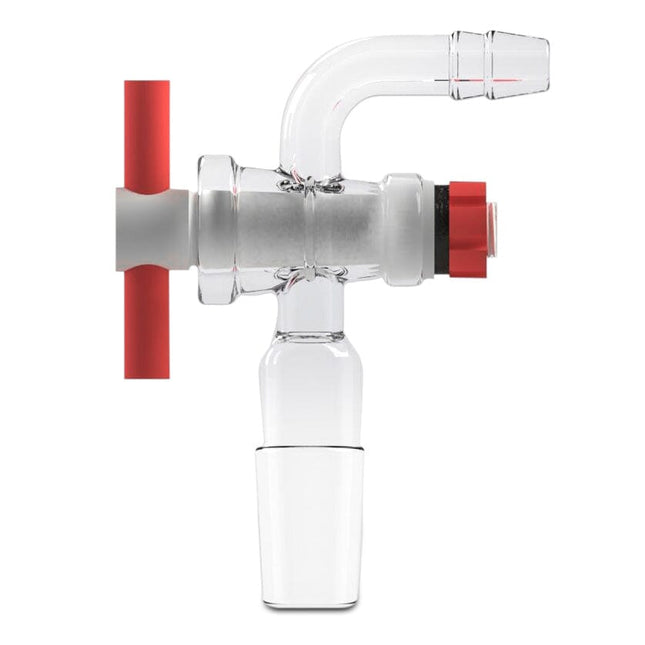
24/29 Valve
24/29 Valve For 10L-50L Best Value Rotary Evaporators. *Notice to customers: All units are inspected for broken glassware or parts before leaving BVV™. If the unit arrives damaged (this does not include minor imperfections or scuffs in glassware), the customer MUST contact BVV™ within 72 hours from carrier delivery to file a claim. If the customer DOES NOT contact BVV™ within 72 hours from carrier delivery, then BVV™ cannot issue any replacement(s) or compensation for the item; a new purchase will need to be made for a replacement. **Glassware Safety Disclaimer: BVV™ is not responsible for failure of glassware which must be inspected before and after every use because it may eventually develop imperfections or damage through normal usage, mishandling, and stress caused by temperature variations. If an imperfection or damage is noted while inspecting the glassware DO NOT use the glassware because it can fail causing bodily harm or damage to the surrounding area.**
$49.02
-


SSP Corporation Male Elbow Tube Fitting
SSP - Duolok Male Elbow SSP Instrumentation Duolok® tube fittings are designed, manufactured and quality controlled to be totally “interchangeable” with the Swagelok® brand of tube fittings. Component by component examination plainly shows the two brands as completely “componentintermixable.” The precision manufacturing of both products to stringent tolerances under rigid quality control procedures ensures the safety, performance, and reliability of service whenever Duolok® and Swagelok® component parts are mixed and used in accordance with published installation and service recommendations. Specifications Connection Type 1 Duolok Tube Fitting Connection Size 1 Specified by User Connection Type 2 Male NPT Connection Size 2 Specified by User Material 316 Stainless Steel ASTM A-276 and A-479 bar stock, A-182 forgings. Duolok Pressure Rating = Tubing Rating NPT Pressure Rating >10,000PSI ASME B31.3 SSP proudly makes Duolok®, TruFit®, FloLok® and hundreds of other products 100% in the USA! Dimensions A 1.06 in Bx 0.77 in By 0.92 in C 0.70 in D 0.60 in E 0.19 in F 0.56 in G 9/16 in H 1/2 in P 1/4 in T 1/4 in
$11.20 - $47.62
-
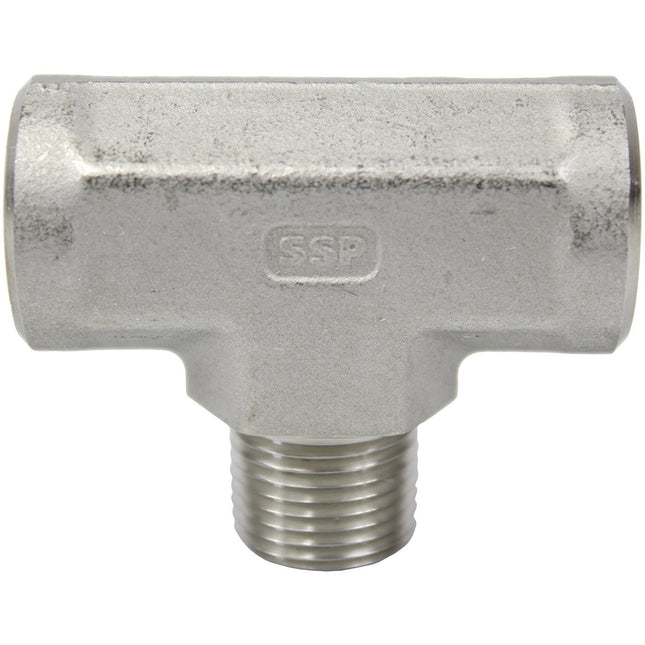

SSP Corporation Branch Tee
SSP - Branch Tee SSP Instrumentation TruFit® is manufactured from fully-traceable raw material to close tolerances and superior surface finishes. TruFit® provides optimal performance when installed in accordance with SSP’s recommendations and the design parameters appropriate for each type of connection – tapered thread, straight thread, and weld & braze. TruFit® components are cleaned in accordance with SSP documented work instructions using equipment calibrated to NIST standards with environmentally-safe and stable agents, ultrasonics, and heat/ temperature to remove all residual oil, grease, and loose particles. Stainless steel components are passivated to the requirements of MIL QQ-P-35 and ASTM A 967. ***Note: ALL NPT Threads REQUIRE the user to properly install the fitting by using a thread sealant to prevent leaks. BVV recommends GAS PTFE Tape Specifications Connection Type 1 Female NPT Connection Size 1 Specified by User Material 316 Stainless Steel ASTM A-276 and A-479 bar stock, A-182 forgings. Working Pressure (PSIG) 1/4" - 7750 3/8" - 6800 NPT Pressure Rating >10,000PSI ASME B31.3 SSP proudly makes Duolok®, TruFit®, FloLok® and hundreds of other products 100% in the USA! Dimensions A 1.76 in E 0.28 in H 3/4 in P 1/4 in L 0.88 in S 1.09 in
$42.01 $28.01
-
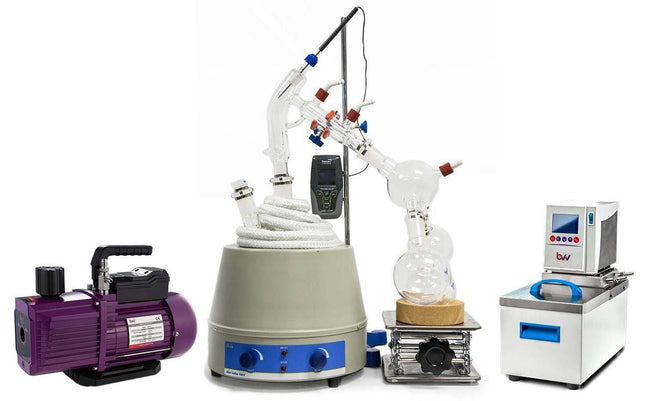

1L Standard Distillation Turnkey Setup
1L Standard Distillation Turnkey Setup The Standard Distillation Turnkey Setup includes all the components necessary to successfully perform distillation at an entry level price point. The Standard Turnkey Setup Includes: 1L Distillation Kit 1/4" Flare x 1/4" Barb Adapter BVV™ 5L Heated Circulator BVV™ V9D 9CFM Two Stage Vacuum Pump Distillation Quick Start Guide This guide gives basic quick start instructions for distillation systems. It is intended to provide a starting point for learning the process. Parameters should be adjusted to suit specific needs, Before beginning distillation, ensure the following steps have been taken: Vacuum Pump is in good working order. Pump should be run against dry load to allow internals to warm up. Oil should be clear. Cloudy or dark oil should be changed. All glass components are in good working order and ready to be assembled A winterization and degassing procedure has been done to prepare oil for distillation Once all three of these steps have been completed, you are ready to begin distilling. Begin by placing stir bar in boiling flask and then load your material. This should be done using a funnel. A small amount of alcohol in the oil will give it a thinner consistency making it easier to transfer. Assemble all glassware and ensure each joint is properly greased. Do not use too much, as the vacuum pressure might pull some grease into the system. To ensure a full seal, spread grease in a circular motion by rotating glassware Attach circulator to condenser and set temperature to 50C. Allow circulator to reach temperature before beginning distillation. Connect vacuum pump to manifold. The manifold will allow you to isolate each individual component as well as let atmosphere into and out of the system. Connect receiving cow to cold trap. Connect cold trap to manifold. Connect vacuum gauge to manifold. At this point, ensure all connections are correct. Also ensure receiving cow is positioned to collect the first fraction in the far-left receiving flask. Circulator should be at its set temperature. Turn on vacuum pump to begin process. Turn on heat and set to 60C. Vacuum pump will begin to pull down and temperature will begin to rise. Watch the gauge to monitor vacuum pressure and stability. Start stir slower and increase speed with temperature. Once you are close to 60C, increase the temperature 20 degrees. Continue to raise the heat incrementally in 20-degree steps, increasing the set temperature as you near your set point. Increase temperatures incrementally until you reach 220C. You will see your first fraction somewhere between 180C and 190C or slightly before. This is the “heads” fraction. You will move to your second fraction when you see an increased reaction in the head, a slight color change toward golden, as well as a thickening of distillate. When this fraction hits, allow the distillate to “self-clean” the head for a minute or two then, rotate the cow to the middle receiving flask. Collect your “main body” fraction. You will see temps between 190-220C during this fraction. Continue to increase stirring speed as necessary. Reaction in the head may vary but it should never stop. As fluid level in the boiling flask decreases, increase stir speed. The final “tails” fraction is a mixture of the first and second fractions and should be saved for re-distillation later. Ideally, you want to turn the cow to the final flask before the tails fraction hits. The “tails” fraction has an obvious color change and will be darker than the “main body” fraction. You will see temps between 200-250C during this fraction. As fluid level in the boiling flask decreases even more, set stirring RPM higher (1000+ RPM). You may need to compensate with a bit more heat to finish of the final fraction as well. Once process is complete, stop heat, stop stir, and stop vacuum. Let atmosphere into the system. Be sure to properly store your distillate as exposure to air and light can cause oxidation. ***Note: This entire setup will ship via motor freight.*** *Notice to Customers: All units are inspected for broken glassware or parts before leaving BVV™. If the unit arrives damaged (this does not include minor imperfections or scuffs in glassware), the customer MUST contact BVV™ within 72 hours from carrier delivery to file a claim. If the customer DOES NOT contact BVV™ within 72 hours from carrier delivery, then BVV™ cannot issue any replacement(s) or compensation for the item; a new purchase will need to be made for a replacement. BVV™ is not responsible for the failure of glassware which must be inspected before and after every use because it may eventually develop imperfections or damage through normal usage, mishandling, and stress caused by temperature variations. If an imperfection or damage is noted while inspecting the glassware DO NOT use the glassware because it can fail, which can cause bodily harm or damage to the surrounding area.
$2,940.94 - $3,291.05
-
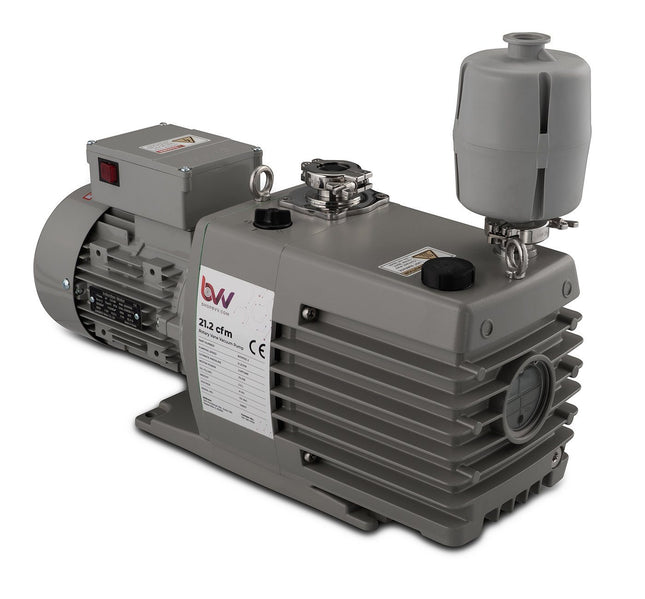

BVV™ Pro Series 21.2CFM Corrosion Resistant Two Stage Vacuum Pump
BVV™ Pro Series 21.2CFM Corrosion Resistant Two Stage Vacuum Pump This is the BVV™ Brand 21.2CFM Two Stage Pro Series vacuum pump. The BVV™ Pro Series 21.2CFM will pull a vacuum down to 0.5mtorr micron effortlessly. The pump is designed with corrosion resistance and long term continuous operation in mind. Comes standard with K-25 fittings, clamps, centering rings and oil mist exhaust filter which returns trapped oil back to the pump and allows for quieter operation. Adjustable gas ballast keeps moisture, solvent, and other contaminants from getting stuck in the pump. Please Refer to these charts for vacuum specifications at altitude and conversions: Vacuum at Altitude Chart Vacuum Conversion Chart Specifications Electrical Requirements: 115v 60Hz Pumping Rate: 21.2CFM Ultimate vacuum without gas ballast: 0.5mtorr Inlet/Outlet connection: KF25/NW25 Flange Oil Volume: 2.3L/2.4 quarts Working Temperature: 5C to 40C Unit Weight: 41KG / 90lbs Recommended oil: Ultragrade 19 CE Compliance: yes Warranty: 2 year limited warranty Pump Warranty Information Customers using solvents such as stabilization resins (MinWax™, Gator Venom™ etc.), alcohol and other polar solvents must use the vacuum pumps in conjunction with a cold trap for evacuations in excess of 5 minutes. (Excludes Cactus Juice™) If the consumer is using the pump for prolonged periods of time exceeding 5 minutes we require that a cold trap is used or the pump warranty is void. These stabilization resins have the ability to break down the internal components of the pump that are plastic resulting in a seized motor voiding all warranties. When evacuation exceeds 5 minutes these solvents begin to vaporize and then re-condense in the vacuum pump reservoir. Once enough solvent re-condenses in the pump displacing the oil the plastic internal components may begin to warp, melt or seize. The use of a cold trap will condense the vapors prior to making their way to the vacuum pump preventing pump damage due to excessive use. Furthermore, Minwax Wood Hardener™ is not to be used with any vacuum pumps, EVER. (A seized motor will result within the first use.) To prevent these issues from happening to your process, change the Oil after each vacuum pump use, Even if the use time is only 5min.
$3,151.00 $2,590.83
-
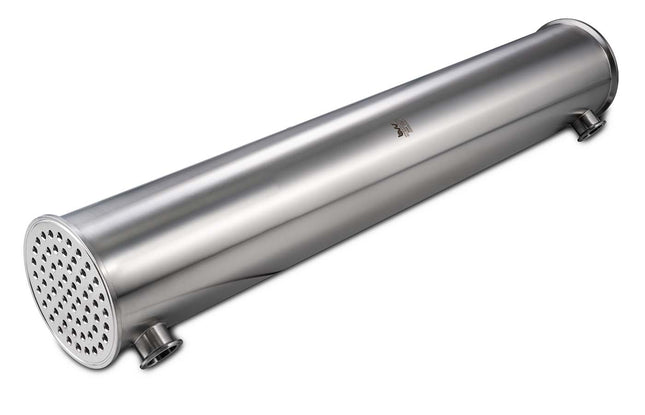

Baffled Condenser - 6" x 36" with 1.5" Tri-Clamp Side Ports
Baffled Condenser - 6" x 36" with 1.5" Tri-Clamp Side Ports This 304 Stainless Steel Tri-Clamp condenser allows the user to condense hot vapors and solvent while running an extraction system or use it as a heat exchanger if needed. It features internal baffles in the system allowing for better overall heat exchange, 6" Tri-Clamp connections on each end and (2) 1.5" Tri-Clamp ports on the side to allow various connections the user may need. From end to end it is 36" in length. The inside diameter of the tubing measures 7.5mm.
$4,201.34
-


Best Value Vacs 1.75 Quart Pyrex Vacuum Chamber - GLASS LID & HOLES
Best Value Vacs 1.75 Quart Pyrex Vacuum Chamber - GLASS LID & HOLES This is a complete BestValueVac® vacuum chamber setup designed built and 100% tested in Naperville, Illinois. With our unique patent pending gasket design (Utility Patent #14/533,548) this chamber is sure to last 10,000 uses with proper care and maintenance. The gasket itself is reversible (doubling the life of our system) allowing customers to instantly take -Please Refer to these charts for vacuum specifications at altitude and conversions: Vacuum at Altitude Chart Vacuum Conversion Chart key Features: Pyrex Glass Vessel Highly Durable and Reversible Silicone Gasket Glycerin filled vacuum gauge User friendly vacuum connections that fit most vacuum pumps on the market 50 Micron Air filter for reducing airborne contaminants when releasing the vacuum Silicone vacuum pad 5' of vacuum rated HVAC hose to pull a vacuum. Specification Chamber Material Pyrex Glass Gasket Material Silicone Lid Material Glass Internal Dimensions (ID) 3" Tall x 6.75" Diameter Vacuum Gauge (Glycerin Filled) InHG (0)-(-30) Manifold Connections 1/4" SAE and 1/4" FNPT Temperature Rating 150°F (65°C) Additional Included Items 5' Purple Vacuum Rated HVAC Hose Platinum Cured Silicone Pad Black 50 Micro Air Filter Compatibility Explanation: BestValueVac® Chambers are not compatible with stabilization resin (i.e. Cactus Juice™, Gator Venom™, Minwax™ etc.), alcohol, ethanol, acetone and acrylic based monomers or polymers.The lid may only be cleaned with soapy water. ShatterVac® chambers are not compatible with stabilization resin (i.e. Cactus Juice™, Gator Venom™, Minwax™ etc.), acetone, acrylic based monomers or polymers. The lid may be cleaned with soapy water and low strength cleaning agents. GlassVac® chambers are compatible with all solvents and stabilization resins. We only recommend and warranty GlassVac® chambers for resin infusion and wood stabilization.The lid may be cleaned with any solvent or cleaning agent. See FAQ at the top for product safety warnings. Pump Warranty Information: Customers using solvents such as stabilization resins (MinWax™, Gator Venom™ etc.), alcohol and other polar solvents must use the vacuum pumps in conjunction with a cold trap for evacuations in excess of 5 minutes. (Exludes Cactus Juice™) If the consumer is using the pump for prolonged periods of time exceeding 5 minutes we require that a cold trap is used or the pump warranty is void. These stabilization resins have the ability to break down the internal components of the pump that are plastic resulting in a seized motor voiding all warranties. When evacuation exceeds 5 minutes these solvents begin to vaporize and then re-condense in the vacuum pump reservoir. Once enough solvent re-condenses in the pump displacing the oil the plastic internal components may begin to warp, melt or seize. The use of a cold trap will condense the vapors prior to making their way to the vacuum pump preventing pump damage due to excessive use. Furthermore, Minwax Wood Hardener™ is not to be used with any vacuum pumps, EVER. (A seized motor will result within the first use.) To prevent these issues from happening to your process, change the Oil after each vacuum pump use, Even if the use time is only 5min. For shipping info including Import/Export details visit our Shipping link at the bottom of the page.
$112.04
-
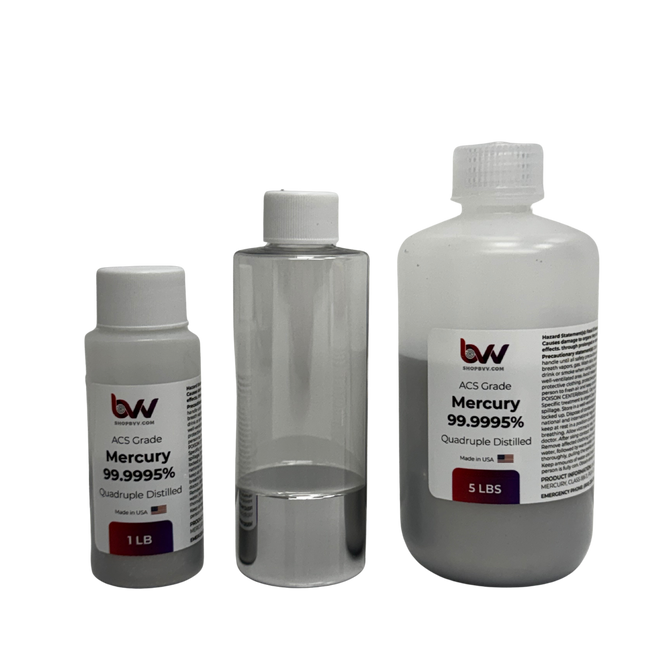
Mercury 99.99995%
Our mercury is virgin quadruple distilled. Its purity is 99.99995%. This product ships as Hazardous material in any quantity, even small vial is required to ship as a regulated hazardous material and carries all the additional handling fees associated. ACS Grade MCT Grade (crystal growth) Dental Grade Reagent Grade Instrument Grade Made in USA Product Shipping and packaging detail. 1lb size ships in a 2oz HDPE bottle 5LB size ships in a 8oz bottle not entirely filled 10lb ships as 2x 5oz bottles. Mercury Certificate of Analysis COA
$105.03 - $1,932.62
-


QTests Cannabis QTest
Cannabis QTest Know Your Dose with the Cannabis QTest The Cannabis QTest is a single-use cannabis test kit that can quickly and easily tell you the percentage of THC and CBD in cannabis flower or buds. You can test as much cannabis as you like, but you need to finely chop and mix it first (or grind it up in a coffee grinder). After you homogenize your material this way, the result of your test will then apply to the all rest of your cannabis. Simply follow the instructions and compare the color of the detection vial to the enclosed color chart. It’s that simple. Instructions Note: A paper version of these instructions comes with your order. IMPORTANT INFORMATION! – READ THIS FIRST • Use this kit at room temperature. (If stored in a refrigerator, let it warm up for one hour first.)• Perform the test on a flat surface during the daytime.• Evaluate the result in daylight immediately after the 10-minute development time. (The color can change if you wait too long.)• Use a white, letter-sized sheet of paper as a background when evaluating the color. (See section four for evaluation details.)• Read all the instructions at least once through before beginning the test. 1. IMPORTANT BACKGROUND INFORMATION This test kit can be used to detect the concentration of active ingredients THC and CBD in cannabis flower. The kit will not work with concentrated extracts, gummies, chocolates, brownies or other edibles. 2. PREPARING FOR THE TEST Take out all the items from your kit. Along with these instructions, you should have: • protective gloves• plastic dropper bottle with green cap (for determining CBD concentration)• glass vial with red lid containing dry crystals (for determining THC concentration)• plastic blister with twist-and-tear-off tip containing developer solution You will also need a milligram scale and either a small funnel or a creased piece of paper to carefully pour the flower material into the plastic extraction bottle. (You can make your own paper funnel. Google it!) Note: If you are testing cannabis flower (buds), you need to homogenize the material before you perform the test. A coffee grinder works best. If you do not have a coffee grinder then you can chop your material finely on a cutting board using a sharp knife. Then mix the chopped material thoroughly. You will be using 20 milligrams (mg) of material for the test. The result will tell you the percentage of THC and CBD in all the remaining cannabis that you honogenized. 3. PERFORMING THE TEST 3.1 First put on the enclosed nitrile gloves and wear appropriate protective clothing and safety glasses. If you wear contact lenses, remove them. The ingredients contain acids which may cause skin irritation or severe eye damage. In the event you come in contact with the ingredients (liquid or dry), remove the affected clothing immediately and rinse the affected skin area with water for several minutes. In case of eye contact, rinse the affected eye with running water for several minutes. (Keep pets, especially cats, away from the testing area.) 3.2 Carefully weigh 20 mg (0.20 g) of your homogenized cannabis using a milligram scale. 3.3 To determine the concentration of CBD in your sample, open the plastic dropper bottle with the green cap (by turning the white part of the cap). Carefully pour the 20 mg of homogenized cannabis flower (or the proportionally lesser amount of concentrated extract) into the bottle using a funnel or a creased piece of paper, then put the lid back on and close it tightly. Next, shake the bottle well for about 12 to 20 seconds, then set it down to rest for 10 minutes. During the resting period, repeat the shaking process two more times; once at about the 3-minute mark, and again at about the 7-minute mark. Each time you set the bottle down to rest, make sure the cannabis material remains inside the liquid. (If you see material stuck in the upper section of the bottle, one or two quick shakes with the bottle in a vertical position will usually rinse it all back down.) After 10 minutes, evaluate the results immediately. If CBD is present, the detection liquid will be a shade of purple. Use the left side of the enclosed color chart to determine the CBD content. For details, see section 4 below, “EVALUATING THE RESULT.” Then come back to this section to perform the THC part of the test. IMPORTANT! – Evaluate the CBD content immediately after the 10-minute mark. You have about three minutes. The liquid will continue to change color after this time and falsify the result. 3.4 To determine the concentration of THC in your sample, open the small glass vial with the red lid. Then remove the green cap from the plastic dropper bottle you just used (not the white part this time, just the green tip) and add 10 drops to the vial. Next you are going to twist and tear off the top of the plastic blister (to open it) and add 5 drops of the liquid into the vial also. IMPORTANT – Before you open the blister, make sure the liquid inside is congregated at the bottom. Otherwise it can spill out when you tear it open. If you see liquid near the top (near the tear point), just shake it a little or tap it on a table so the liquid drops down to the bottom. Then it is safe to twist and tear off the top. After adding five drops of liquid from the blister, put the red lid back on the glass vial and close it tightly, then gently move the vial from side to side to mix the ingredients. 3.5 The liquid in the glass vial will change color almost immediately (within 10 seconds). Use the right side of the enclosed color chart to determine the THC content of your material. See section 4 below for details. 4. EVALUATING THE RESULT Follow the instructions above before evaluating the result. EVALUATING THE CBD CONTENT (THE PLASTIC BOTTLE WITH THE GREEN LID) The detection reagent in the plastic dropper bottle will not change color in the presence of THC, but only in the presence of CBD. Use the left side of the color chart and the “SPECIFIC EVALUATION INSTRUCTIONS” below to determine the concentration. EVALUATING THE THC CONTENT (THE SMALL GLASS VIAL WITH THE RED LID) If there is THC in the material, the liquid in the small vial will turn purple. Use the right side of the color chart and the “SPECIFIC EVALUATION INSTRUCTIONS” below to determine the concentration. If there is no THC but there is CBD, the liquid in the small vial will turn orange. If there is neither THC nor CBD, the liquid in the small vial won’t change color (or will turn slightly gray). SPECIFIC EVALUATION INSTRUCTIONS By comparing the intensity or saturation of the liquid in the vial with the enclosed color chart, you can determine the result visually. Daytime sunlight is best suited for optimal evaluation. If using artificial light, the influence of different color temperatures may slightly change the hue. You can still perform the evaluation, but you should take this into account (e.g. high blue content in energy-saving lamps, green discoloration when using LED light from cell phones, etc). • Use a white, letter-sized sheet of paper as a background.• In daylight or under bright light, hold the glass vial next to the color chart about six to eight inches in front of the white sheet of paper and look through the glass vial head on. For best results, your eyes should be fairly close to the vial, but no closer than about six to eight inches.• Now compare the color of the liquid in the vial to the color chart. The corresponding concentration of THC and CBD is listed as a percentage. • This concentration applies to your remaining homogenized cannabis. • Do not evaluate the liquid after four hours. At this time the color may no longer be reliable. 5. STORAGE AND SHELF LIFE Store the reagents in the refrigerator (35° – 46° F) and out of direct sunlight for a shelf life of at least 18 months. 6. WARNINGS • Keep the kit away from children and animals.• When performing the test, wear suitable protective gloves, clothing and face/eye protection. If you wear contact lenses, remove them before using the test kit.• The liquids contained in the test kit consist of various acids which may cause a corrosive/irritating effect on the skin or severe eye damage/irritation. Avoid contact with the skin, eyes, mouth or clothing.• Should contact with the above listed areas occur, remove the relevant clothing immediately. Instantly rinse the affected skin areas with water for several minutes. In case of contact with the eyes, immediately rinse them with water for several minutes using both hands to keep the upper and lower eyelids open.• Substances processed with the test kit are not to be consumed! 7. DISCLAIMERS • QTests are only to be used for the detection and quantification of unknown substances.• The result may not be 100% accurate. Your sample could be adulterated with one or more unknown substances that cross-react with the reagents, affecting the quantitative result.• The result does not mean your sample is safe to consume. It could still contain unwanted substances and impurities that can be harmful or even deadly.• The Cannabis QTest is not a substitute for laboratory analysis.• miraculix and/or Qtests.org assume no responsibility for the use or misuse of the test kit or the results. 7. DISPOSAL OF MATERIALS Check your local regulations for proper disposal of acids.
$34.94 $28.01
-
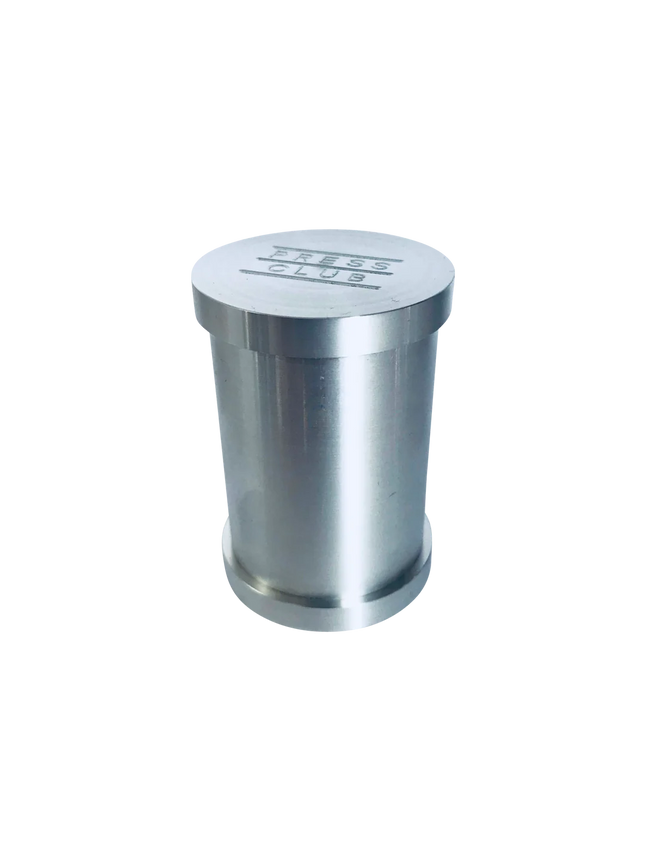

The Press Club Press Club’s 100% Aluminum Pre-Press Mold
PRE-PRESS MOLD The Press Club 100% aluminum pre-press molds help you quickly condense your start material before pressing. Pre-press molds will not only save you time but will help you achieve more uniform results and increase yields. 1.5" x 2.5" This 1.5" x 2.5" pollen press creates a circular puck (approximately the size of a quarter) that fits perfectly inside a bag. Made in the USA. 2" x 4" This 2" x 4" pre-press mold creates a rectangular slab that that fits perfectly inside a 2" x 4" bag or larger. Made in the USA. 2" x 9" This 2" x 9" pre-press mold creates a rectangular slab that that fits perfectly inside a 2" x 9" bag or larger. Made in the USA. 2.5" x 2.5" This 2.5" x 2.5" mold creates a square slab that fits perfectly inside a 2.5" x 4.5" rosin bag. Made in the USA. 2.5" x 4.5" This 2.5" x 4.5" pre-press mold creates a rectangular slab that that fits perfectly inside a 2.5" x 4.5" bag or larger. Made in the USA. 2.5" x 9" This 2.5" x 9" pre-press mold creates a rectangular slab that that fits perfectly inside a 2.5" x 9" bag or larger. Made in the USA. 3" x 5" This 3" x 5" mold creates a rectangular slab that fits perfectly inside a 3" x 6" filter bag. Made in the USA. 4" x 7" This 4" x 7" pre-press mold creates a rectangular slab that that fits perfectly inside a 4" x 7" bag or larger. Made in the USA.
$83.96 - $238.01
-


Terpenes Sativa
BVV™ Terpenes Sativa All sales are final. Orders can be refunded prior to fulfillment and shipping but once the order has been fulfilled and/or shipped, no refunds will be issued. Due to the hazardous nature of our product, we are unable to accept returns. BVV™ Terpenes are botanically derived terpenes enhanced with "nature-identical" artificial flavors. These flavors boost the natural flavor profile of the terpenes, providing the user with a more pleasant vaping experience. In order to provide complete transparency and elicit customer confidence, all ingredients are disclosed in the technical data sheet. BVV Sativa Safety Data Sheet SATIVA: This terpene is robust and has a distinct citrus, menthol flavor with a touch of sour. Sativa tends to be more stimulating and gives you an energy boost. It can uplift mood, and may reduce anxiety. Best for daytime to assist with creativity throughout your day. FRAGRANCE: Spicy and Sweet. EFFECT: Tends to be more stimulating. It can uplift mood, and may reduce anxiety. Best for daytime to assist with creativity throughout your day. Storage Requirements: Keep in the original container, lid securely tightened and away from heat, open flames, sunlight, combustible materials, and hot surfaces. Store below 15℃ (60℉). Improper storage can cause terpenes to degrade. Dilution: Terpenes must be diluted prior to use for flavor and effect (1-5% by total volume). Terpenes are oil soluble and mix well with plant extracts, coconut oil, and more. Handle With Care: Can cause skin irritation, do not ingest PRIOR to dilution.
$15.40 - $231.07
-
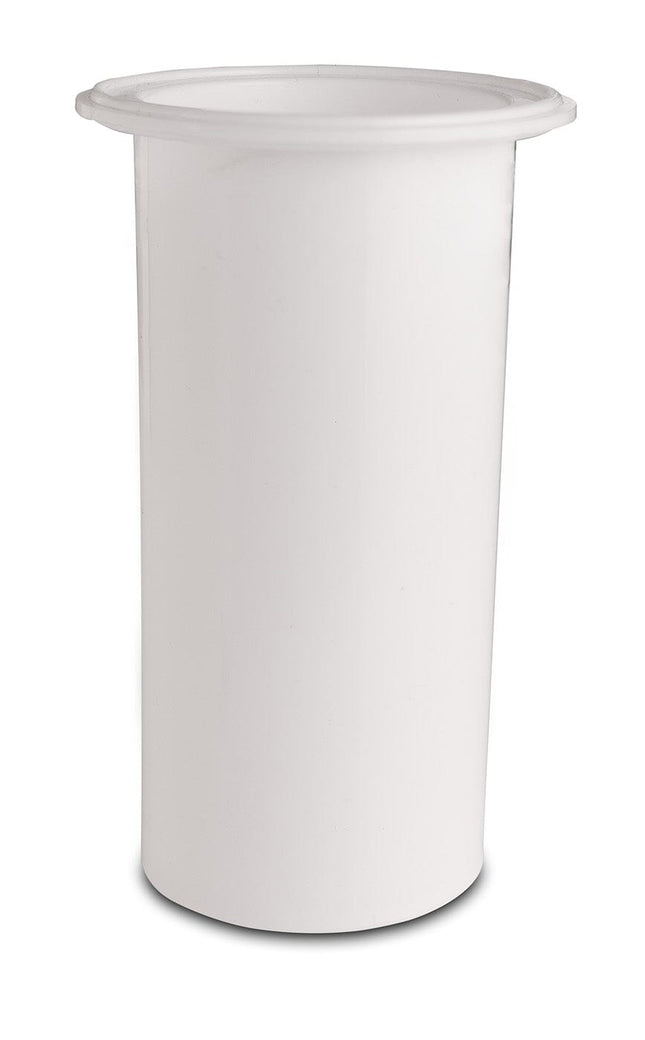

AFS Empty 2.5" CRC Botanical Extraction Filter Cup
2.5" CRC Botanical Extraction Filter Cup
$20.99 $15.40
-
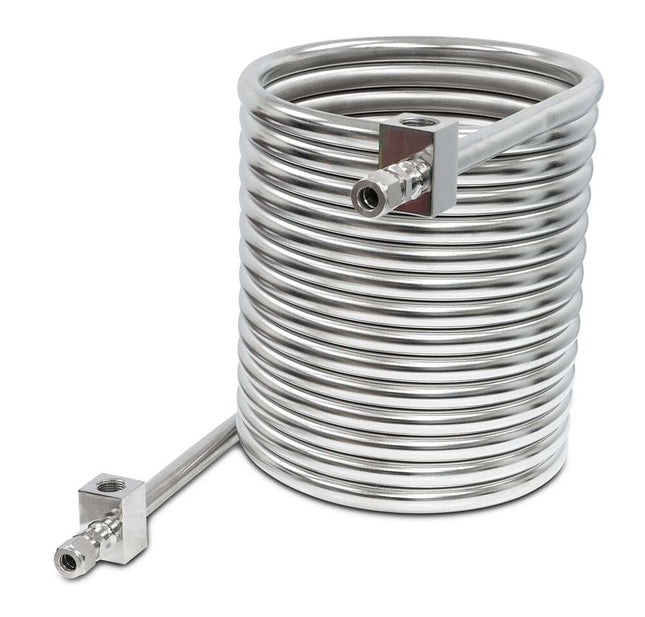

Welded Coil in Coil
Welded Coil in Coil The Jacketed coil is a 40ft length of 1/2" tube that is completely encapsulated by the 3/4" outer jacket. The inner tube has 1/2" compression fittings and the outer tube has 1/2" FNPT connection ports. The built version comes with USA made SSP instrumentation valves with 1/2" JIC connection for the inner tube and either 1/2" MJIC, 1/2" OR 3/4" hose barb connections for the outer tube. The Coil itself is 10" In diameter and can be mounted successfully utilizing one of our 10" Pipe Hangers
$833.27 - $2,089.47
-
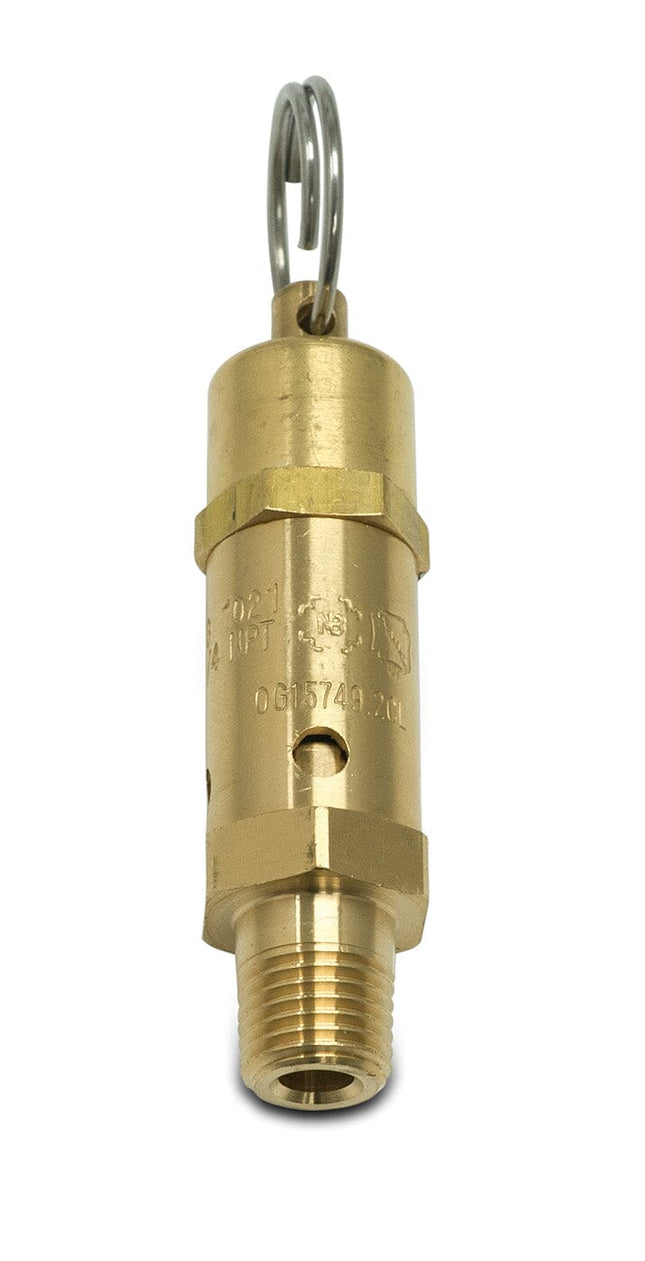

ASME-Code Fast-Acting Pressure-Relief Valve for Air, Test Ring, Brass Seal, 1/4 NPT, 3-1/8" High
ASME-Code Fast-Acting Pressure-Relief Valve for Air, Test Ring, Brass Seal, 1/4 NPT, 3-1/8" High Valve Function Pressure Relief For Use With Air, Inert Gas Activation Pressure Driven Inlet Pipe Size 1/4 Connection Type Pipe Pipe Connection Type Threaded Connection NPT Male Location Bottom Maximum Pressure 300 psi Relief Port Connection Type Vent Relief Port Location Side Set Pressure Configuration Nonadjustable Temperature Range -40° to 400° F Valve Shape 90° Elbow Valve Body Shape Straight Overall Height 3 1/8" Material Body Brass Seal Brass Test Mechanism Ring Valve Type Pop Safety Specifications Met ASME BPVC.VIII RoHS RoHS 3 (2015/863/EU) compliant with exemption 6(c) - Lead in copper alloy REACH REACH (EC 1907/2006) (07/08/2021, 219 SVHC) Compliant DFARS Specialty Metals COTS-Exempt Country of Origin United States USMCA Qualifying No Schedule B 848140.0000 ECCN EAR99 To protect against damage in air lines, air receivers, compressor tanks, and other air-powered equipment, these valves spring fully open at the set pressure and remain open until the system pressure is restored below the set pressure. All meet ASME Code Section VIII for use with air and inert gas pressure vessels. They have a vented relief port to exhaust discharge directly.
$77.02
-
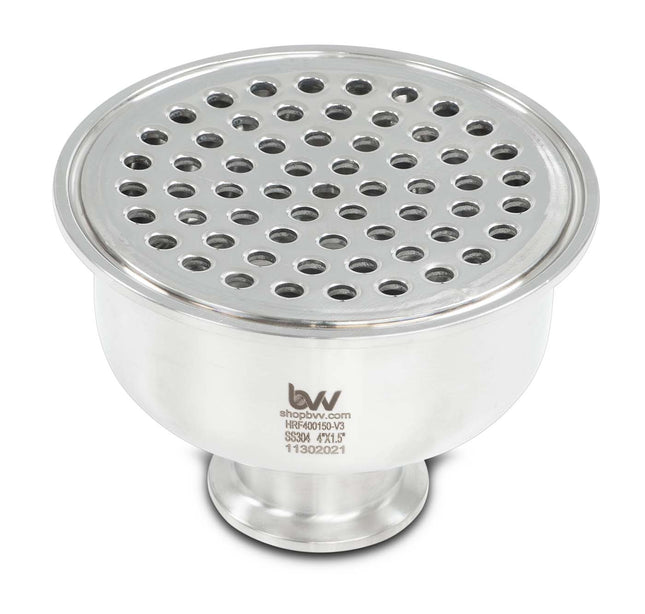

Hemispherical Reducer with Filter Plate V3
Hemispherical Reducer with Filter Plate V3 This hemispherical reducer has a built-in filter plate that is welded flush with the top of the reducer. This unique design allows the user to save even more space by combining a filter plate and hemispherical reducer. Made out of 304 stainless steel the filter plate is welded into the hemispherical reducer and has Tri-Clamp connections on both ends.
$84.03 - $441.14
-
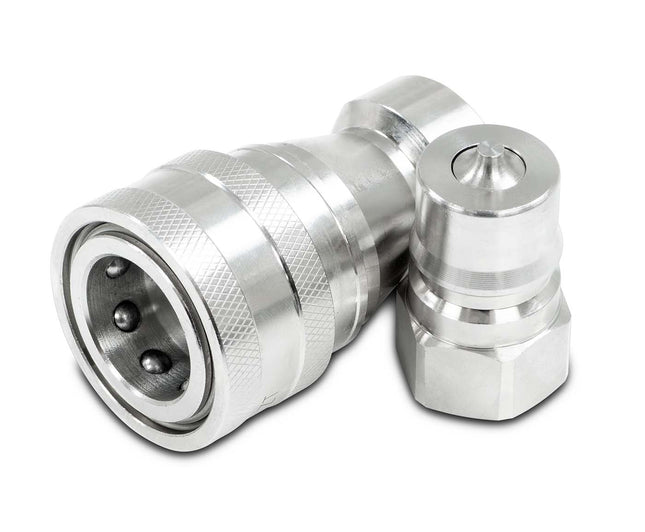

BVV Quick Disconnect Male and Female 1/2" FNPT
BVV Quick Disconnect Male and Female 1/2" FNPT Description [Size]: 1/2" Female NPT; Pressure-proof: 1500 PSI; Flow:12 gpm. [Quality Materials]: The Quick Disconnect is made of high quality 304 stainless steel and The sealing material is made of fluorine rubber which is durable, stable, rust and corrosive resistance and good for long time using. [Precise Design]: Steel balls are used to connect the adapter which makes the sealing better, both ends open-closed. [High Working Temp. & Wide Range of Applications]: The Quick Disconnect provides good sealing and easy to unload. It can be used for connecting two pipes in the double seal system. It is suitable for different media including water, gas, and oil with working at -4°F~392°F.
$196.06
-
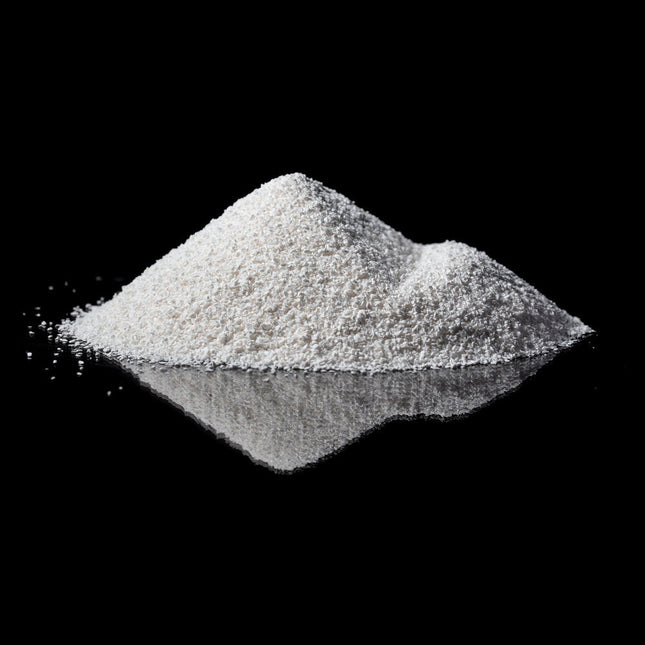
ChemTek CHEMTEK Granular Activated Alumina
Granular activated alumina is neutral pH adsorbent used to remove moisture, free fatty acids, and phospholipids to speed up crystallization and to improve the end products’ oxidative stability.
$105.03 - $1,120.36
You have seen 960 out of 1653 products










































































